

Zitierweise / cite as:
Payer, Alois <1944 - >: Chronik Thailands = กาลานุกรมสยามประเทศไทย. -- Chronik 1890 (Rama V.). -- Fassung vom 2016-02-26. -- URL: http://www.payer.de/thailandchronik/chronik1890.htm
Erstmals publiziert: 2013-09-25
Überarbeitungen: 2016-02-26 [Ergänzungen] ; 2015-12-30 [Ergänzungen] ; 2015-10-26 [Ergänzungen] ; 2015-06-27 [Ergänzungen] ; 2015-04-21 [Ergänzungen] ; 2014-12-12 [Ergänzungen] ; 2014-11-09 [Ergänzungen] ; 2014-03-04 [Ergänzungen] ; 2013-11-04 [Ergänzungen] ; 2013-10-11 [Ergänzungen] ; 2013-09-28 [Ergänzungen]
©opyright: Dieser Text steht der Allgemeinheit zur Verfügung. Eine Verwertung in Publikationen, die über übliche Zitate hinausgeht, bedarf der ausdrücklichen Genehmigung des Herausgebers.
Dieser Text ist Teil der Abteilung
Thailand von
Tüpfli's Global Village Library
ช้างตายทั้งตัวเอาใบบัวปิดไม่มิด
|
Gewidmet meiner lieben Frau Margarete Payer die seit unserem ersten Besuch in Thailand 1974 mit mir die Liebe zu den und die Sorge um die Bewohner Thailands teilt. |
|
Bei thailändischen Statistiken muss man mit allen Fehlerquellen rechnen, die in folgendem Werk beschrieben sind:
Die Statistikdiagramme geben also meistens eher qualitative als korrekte quantitative Beziehungen wieder.
|
1890 - 1898
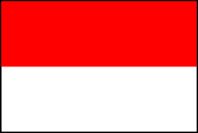
Tuan Long Bongsu Bin Sultan Phraya Long Muhammad (Sultan Sulaiman Sharafuddin Syah / Phraya Pattani IV) ist Sultan (سلطان) von Patani (ڤتاني)
Abb.: Lage des Sultanats von Patani (كراجأن ڤتاني)
[Bildquelle: Xufanc / Wikimedia. -- Creative Commons Lizenz (Namensnennung, share alike)]]
1890 - 1891
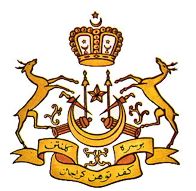
Sultan Muhammad III ibni Sultan Ahmad ibni al-Marhum Sultan Ahmad (1875 - 1891) ist Sultan (سلطان) Kelantan (كلنتن)
Abb.: Lage von Kelantan (كلنتن)
[Bildquelle: Constables Hand Atlas of India, 1893. -- Pl. 59]
"1890–1891: Sultan Muhammad III ibni Sultan Ahmad ibni al-Marhum Sultan Ahmad [Sultan Bongsu], Sultan and Yang di-Pertuan Besar of the State of Kelantan.
- b. 1845, eldest son of Paduka Sri Sultan Ahmad ibni al-Marhum Muhammad, Sultan and Yang di-Pertuan Besar of the State of Kelantan,
- educ. privately.
- Appointed Raja Bendahara and Tengku Sri Indra before his accession.
- Appointed as Heir Apparent with the title of Raja Kelantan, 30 September 1887.
- Succeeded on the death of his father, 8 March 1890.
- Installed as Sultan and Yang di-Pertuan Besar, at Istana Balai Besar, Kota Bharu, 23 September 1890.
- m. (first) Tengku Sofia binti al-Marhum Tengku Putih, Tengku Ampuan, eldest daughter of Tengku Puteh ibni al-Marhum Sultan Phaya Long Muhammad, Raja of the State of Patani, by his first wife, Tengku Putri Cik binti al-Marhum Sultan Muhammad [Engku Na Nik], Tengku Raja, daughter Paduka Sri Sultan Muhammad II ibni al-Marhum Tengku Temenggong Long Tan, Sultan and Yang di-Pertuan Besar of the State of Kelantan.
- m. (second)
- He died at Istana Balai Besar, Kota Bharu, 11 May 1891 (bur. Royal Cemetery, Kampung Langgar)"
[Quelle: http://en.wikipedia.org/wiki/Sultan_of_Kelantan. -- Zugriff am 2015-02-28]
1890
Schaffung von 12 Ministerien:
Innenministerium, gleichzeitig zuständig für Nordsiam und Laos (Nordostsiam)
Verteidigungsministerium, gleichzeitig zuständig für Südsiam, Ostsiam, Malya
Ministerium von Nakorn Barn, zuständig für Polizei, Rekrutierung, Strafvollzug
Außenministerium
Finanzministerium
Palastministerium
Ministerium für Landwirtschaft, Forsten, Bergbau und Handel
Justizministerium
Ministerium für öffentliche Arbeiten
Erziehungsministerium
Kriegsministerium
Ministerium für brahmanische Zeremonien
1890
Budget des Erziehungsdepartments: 159.400 Baht
Abb.: Ausgaben des Erziehungsdepartments 1890/1891 (in Prozent des Budgets von 159.400 Baht)
[Datenquelle: Wyatt, David K. <1937 - 2006>: The politics of reform in Thailand : education in the reign of King Chulalongkorn. -- New Haven : Yale UP, 1969. -- 425 S. : Ill. ; 23 cm. -- (Yale Southeast Asia studies ; 4). -- SBN 300-01156-3. -- S. 128]
"Administrative salaries, allowances, and expenses made up more than half (53.5 percent) of the total expenditures in 1890/91, which amounted to 159,393 baht. Another 8 percent of the budget was expended on special activities placed under the department more or less for financial convenience, such as the school for royal princes in the Grand Palace and the Buddhist Academy at Wat Mahathat [วัดมหาธาตุ ยุวราชรังสฤษฎิ์ ราชวรมหาวิหาร]. Five percent of the budget went for repairs to buildings and for the printing of textbooks. The remainder, 22.8 percent for special schools and 10.7 percent for monastery schools, was used for instruction per se. These proportions seem relatively low, but it may be argued that they were reasonable. Expenditure per pupil was exceedingly low in the monastery schools, but what might otherwise have been the heaviest expenses of such instruction were eliminated by using preexisting or privately furnished buildings as schools and, in some cases, by employing teacher-monks for a nominal salary.
The three special schools, which required more than twice the amount expended on forty-eight monastery schools, were made expensive by the high salaries demanded by foreign teachers (S. G. McFarland [Samuel Gamble McFarland, 1830 - 1897] received 640 baht per month, while teachers in the monastery schools received 10 baht per month or less). In addition, a proportion of the amount expended on administrative salaries was used to support instruction in the monastery schools through the provision of textbooks, the administration of examinations, and the inspection of schools."
[Quelle: Wyatt, David K. <1937 - 2006>: The politics of reform in Thailand : education in the reign of King Chulalongkorn. -- New Haven : Yale UP, 1969. -- 425 S. : Ill. ; 23 cm. -- (Yale Southeast Asia studies ; 4). -- SBN 300-01156-3. -- S. 127f.]
1890
Die Regierung gibt nicht mehr wie seit 1875 Schulbücher gratis ab.
1890/1891
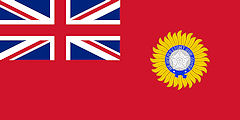
Erziehungsminister Prinz Damrong [สมเด็จพระเจ้าบรมวงศ์เธอ พระองค์เจ้าดิศวรกุมาร กรมพระยาดำรงราชานุภาพ, 1862 - 1942] besucht British Burma, um dass dortige Erziehungssystem zu studieren.
1890ff

Es erscheint:
Morant, Robert Laurie <1863 – 1920>: บันใด : แบบเรียน ภาษา อังกฤษ = Ladder of knowledge. -- Bangkok : Government Education Office.
- Fifty steps steps towards speaking English
- One hundred steps toward reading English
- Fifty steps towards English composition, with special reference to the difficulties of the English verbs
- Fifty steps towards English translation, English grammar & letter writing
[jeweils mit Thai-Titel]
nach 1890
Abb.: Siamesische Kriegselefanten mit Kanonen
1890
Die Armee besteht offiziell (auf dem Papier) aus
- 5.676 Mann
Davon sind
- 1799 Offiziere
- 1532 in Bangkok
- 267 in den Provinzen
- 3877 Truppen
- 2666 in Bangkok
- 1211 in den Provinzen
1890
Abb.: Betel-kauende Frauen, Yasothon (ยโสธร), 1890
Abb.: Lage von Yasothon (ยโสธร)
[Bildquelle: CIA. -- Public domain]
1890

Abb.: Badevergnügen im Königspalast, Bangkok, 1890
Abb.: Im Königspalast, Bangkok, 1890
Abb.: Im Königspalast, Bangkok, 1890
Abb.: Im Königspalast, Bangkok, 1890
1890
Abb.: Adlige, Surin (สุรินทร์), 1890
Abb.: Adlige, Surin (สุรินทร์), 1890
Abb.: Lage von Surin (สุรินทร์)
[Bildquelle: CIA. -- Public domain]
1890
Abb.: Dorf in der Provinz Chainat (ชัยนาท), 1890
Abb.: Lage von Chainat (ชัยนาท)
[Bildquelle: CIA. -- Public domain]
1882 - 1890
Jahresniederschlag (Regen) in Bangkok:
Abb.: Jahreniederschlag in Bangkok (in cm) 1882 - 1890
[Datenquelle: Smyth (1898). -- Vol. II, S. 267]
1890
Monatlicher Niederschlag (Regen) in Bangkok:
Abb.: Monatlicher Niederschlag (in mm) in Bangkok 1890
[Datenquelle: Smyth (1898). -- Vol. II, S. 267]
Abb.: Regenwolken über Bangkok, Juli 2007
[Bildquelle: Brendio. -- http://www.flickr.com/photos/brendio/1428904409/. -- Zugriff am 2012-02-18. -- Creative Commons Lizenz (Namensnennung, keine kommerzielle Nutzung, share alike)]
1890
Monatliche Höchst- und Mindesttemperaturen in Bangkok:
Abb.: Monatliche Höchst- und Mindesttemperaturen (in °C) in Bangkok 1890
[Datenquelle: Smyth (1898). -- Vol. II, S. 267]
Siam um 1890
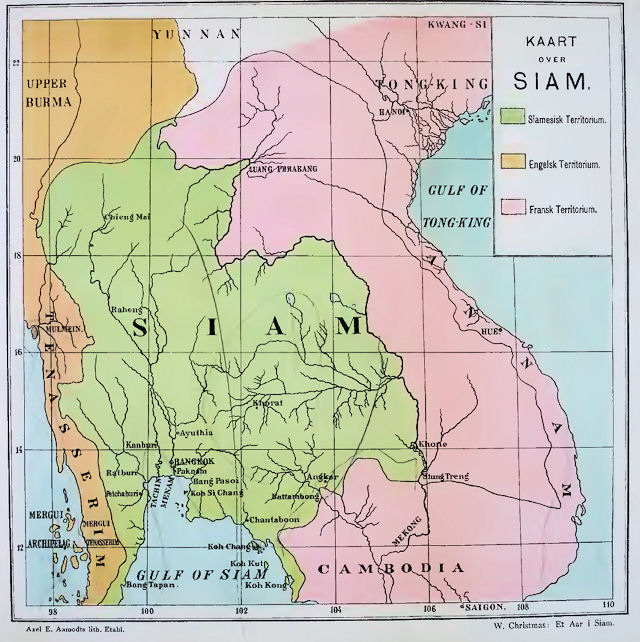
Abb.: Karte von Siam um 1890
[Bildquelle: Christmas, Walter <1861 - 1924>: Et aar i Siam. --
Kjøbenhavn : Hegel, 1894. -- Buchende]
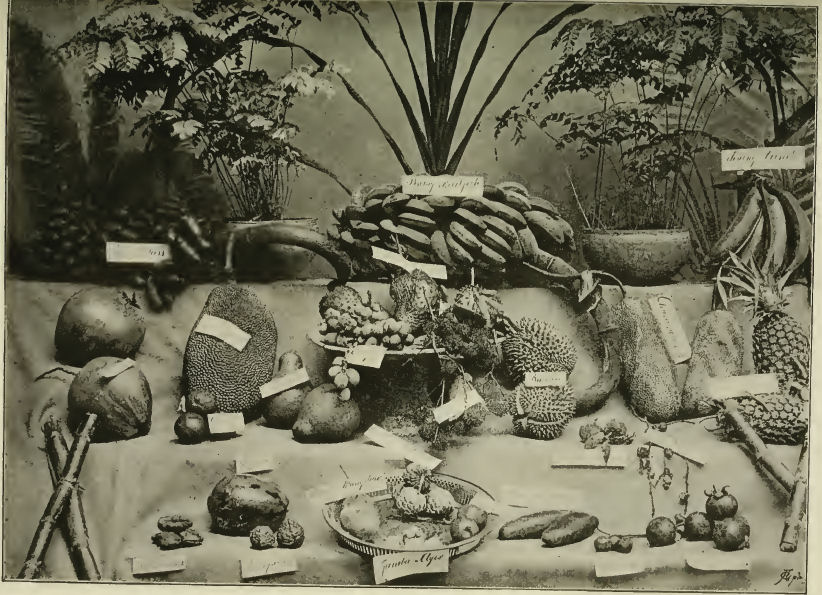
Abb.: Früchte
[Bildquelle: Christmas, Walter <1861 - 1924>: Et aar i Siam. --
Kjøbenhavn : Hegel, 1894. -- S. 235]
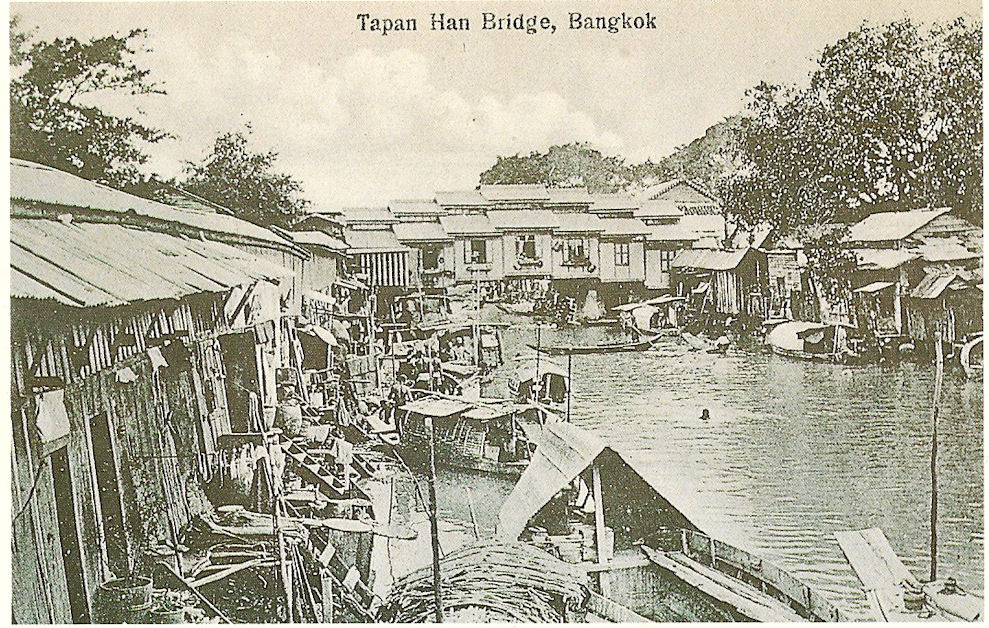
Abb.: Bangkok um 1890: Vorbild Rialto-Brücke (Venedig): Tapan Han Brücke,
Bangkok, Postkarte, um 1890
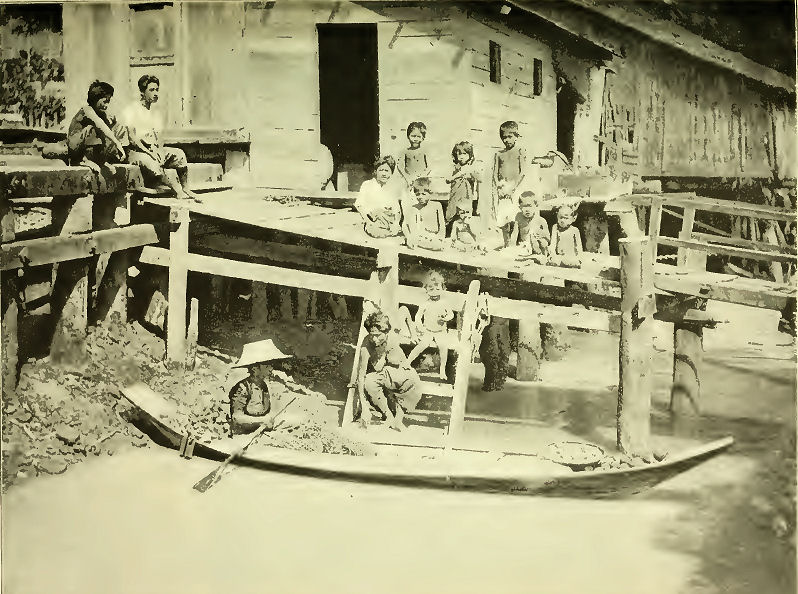
Abb.: Szene am Fluss, Bangkok
[Bildquelle: Christmas, Walter <1861 - 1924>: Et aar i Siam. --
Kjøbenhavn : Hegel, 1894. -- S. 29]
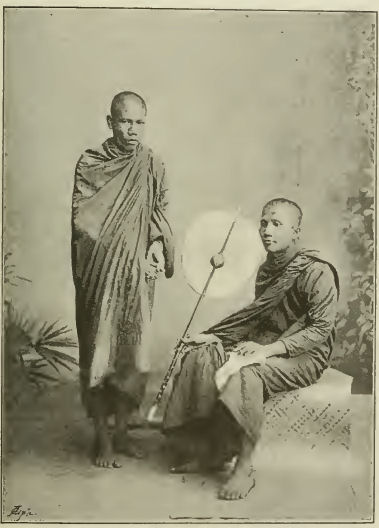
Abb.: Mönche
[Bildquelle: Christmas, Walter <1861 - 1924>: Et aar i Siam. --
Kjøbenhavn : Hegel, 1894. -- S. 91]

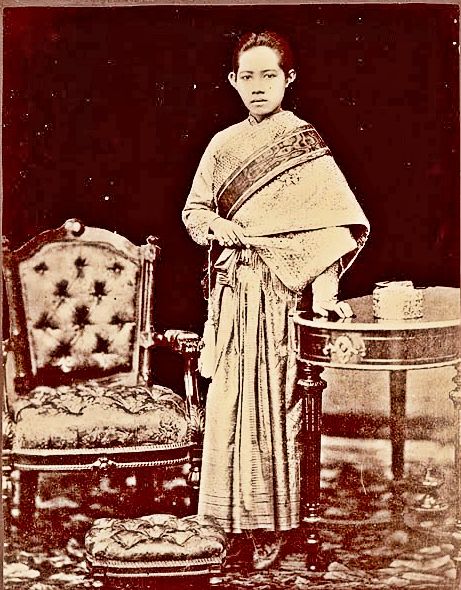
Abb.: Königin Königin Savang Vadhana (สมเด็จพระศรีสวรินทิราบรมราชเทวี, 1862 -
1955)
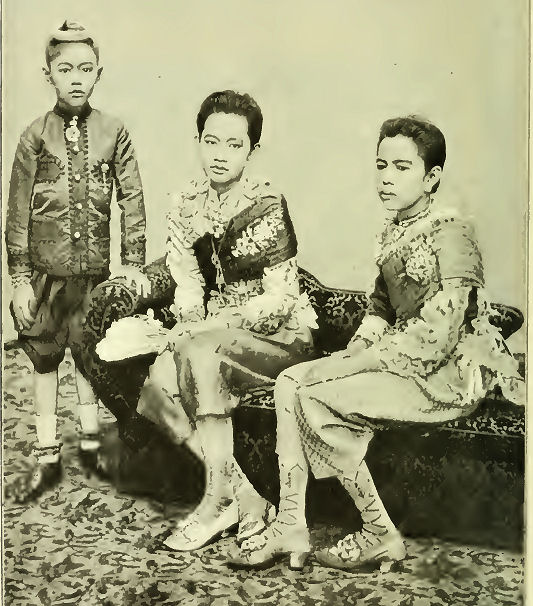
Abb.: Im Palast
[Bildquelle: Christmas, Walter <1861 - 1924>: Et aar i Siam. --
Kjøbenhavn : Hegel, 1894. -- S. 38]
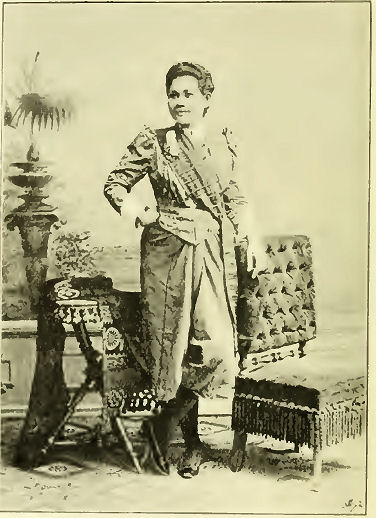
Abb.: Siamesische Dame
[Bildquelle: Christmas, Walter <1861 - 1924>: Et aar i Siam. --
Kjøbenhavn : Hegel, 1894. -- S. 76]
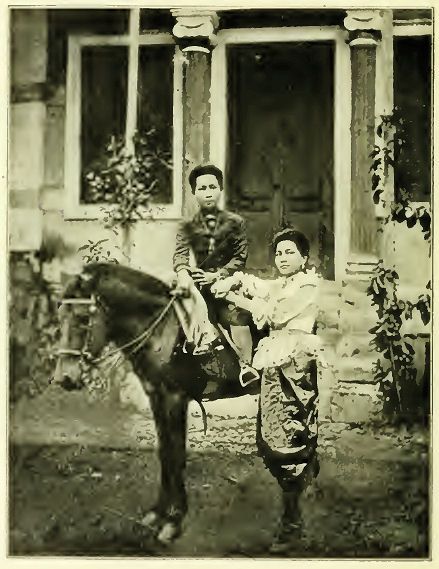
Abb.: Adlige
[Bildquelle: Christmas, Walter <1861 - 1924>: Et aar i Siam. --
Kjøbenhavn : Hegel, 1894. -- S. 78]
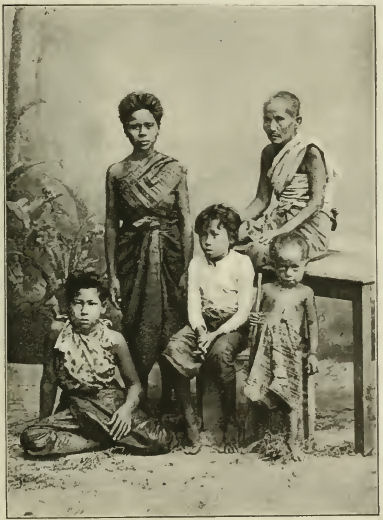
Abb.: Siamesische Familie
[Bildquelle: Christmas, Walter <1861 - 1924>: Et aar i Siam. --
Kjøbenhavn : Hegel, 1894. -- S. 79]
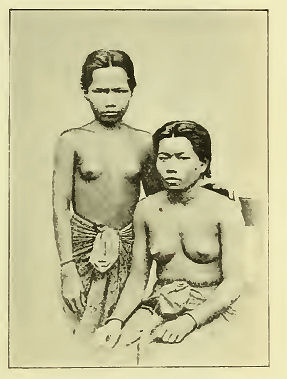
Abb.: Siamesinnen, Bangkok
[Bildquelle: Christmas, Walter <1861 - 1924>: Et aar i Siam. --
Kjøbenhavn : Hegel, 1894. -- S. 77]
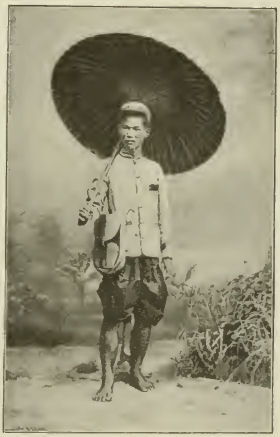
Abb.: Postbote
[Bildquelle: Christmas, Walter <1861 - 1924>: Et aar i Siam. --
Kjøbenhavn : Hegel, 1894. -- S. 83]
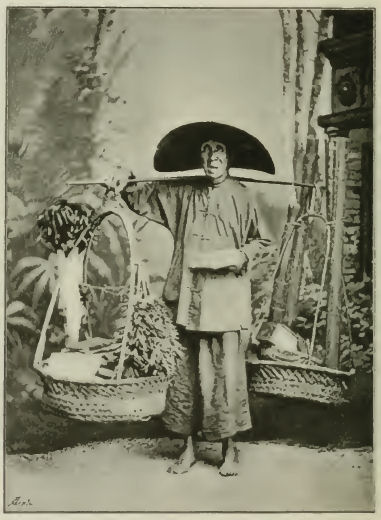
Abb.: Chinesischer Händler
[Bildquelle: Christmas, Walter <1861 - 1924>: Et aar i Siam. --
Kjøbenhavn : Hegel, 1894. -- S. 98]
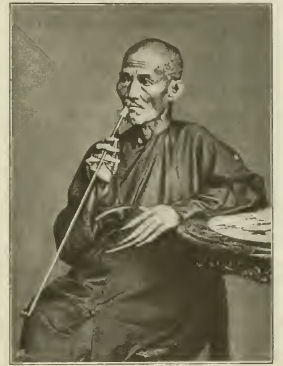
Abb.: Chinese
[Bildquelle: Christmas, Walter <1861 - 1924>: Et aar i Siam. --
Kjøbenhavn : Hegel, 1894. -- S. 99]
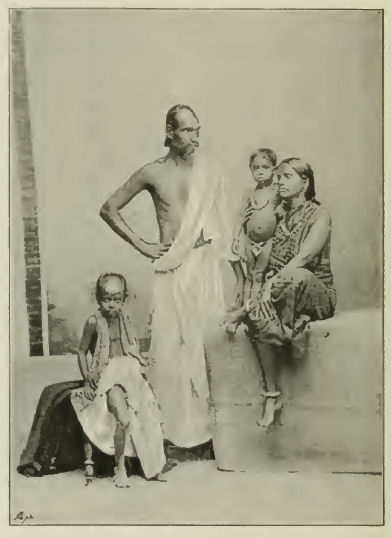
Abb.: Hindufamilie, Bangkok
[Bildquelle: Christmas, Walter <1861 - 1924>: Et aar i Siam. --
Kjøbenhavn : Hegel, 1894. -- S. 284]
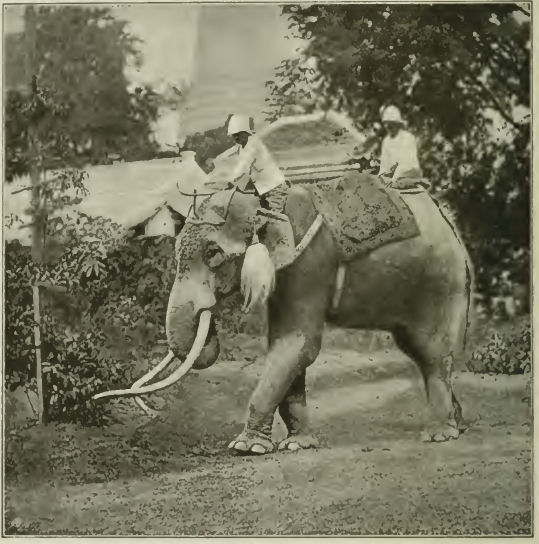
Abb.: Weißer Elefant (ช้างเผือก)
[Bildquelle: Christmas, Walter <1861 - 1924>: Et aar i Siam. --
Kjøbenhavn : Hegel, 1894. -- S. 230]
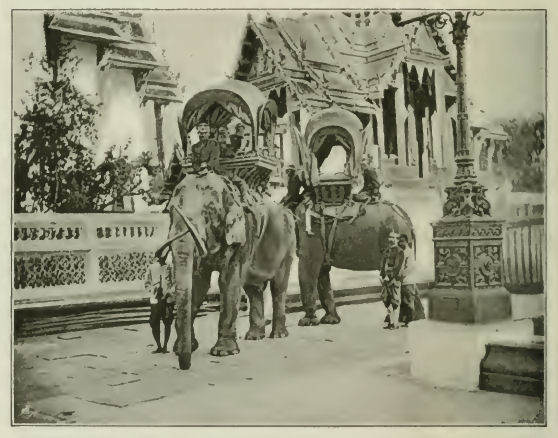
Abb.: Elefantentaxi
[Bildquelle: Christmas, Walter <1861 - 1924>: Et aar i Siam. --
Kjøbenhavn : Hegel, 1894. -- S. 126]
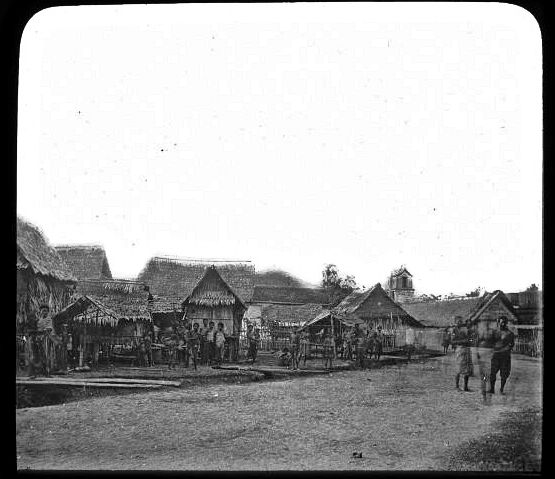
Abb.: Fischerdorf Songkhla Klai, 1890
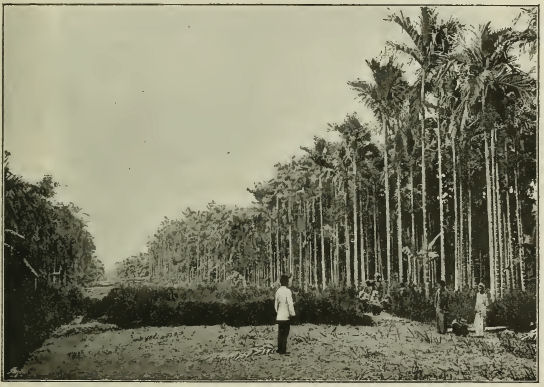
Abb.: Plantage von Betelnusspalmen (Areca catechu L.)
[Bildquelle: Christmas, Walter <1861 - 1924>: Et aar i Siam. --
Kjøbenhavn : Hegel, 1894. -- S. 135]
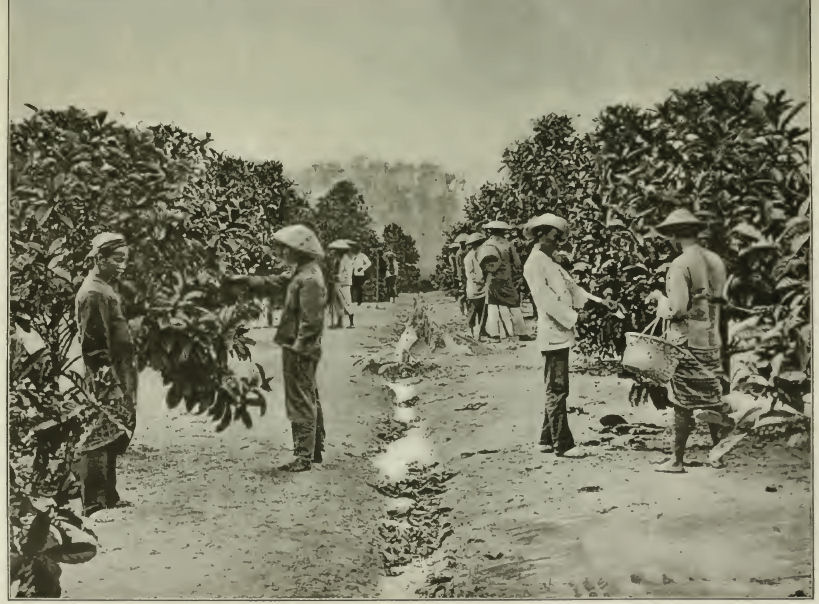
Abb.: Kaffeeplantage
[Bildquelle: Christmas, Walter <1861 - 1924>: Et aar i Siam. --
Kjøbenhavn : Hegel, 1894. -- S. 138]
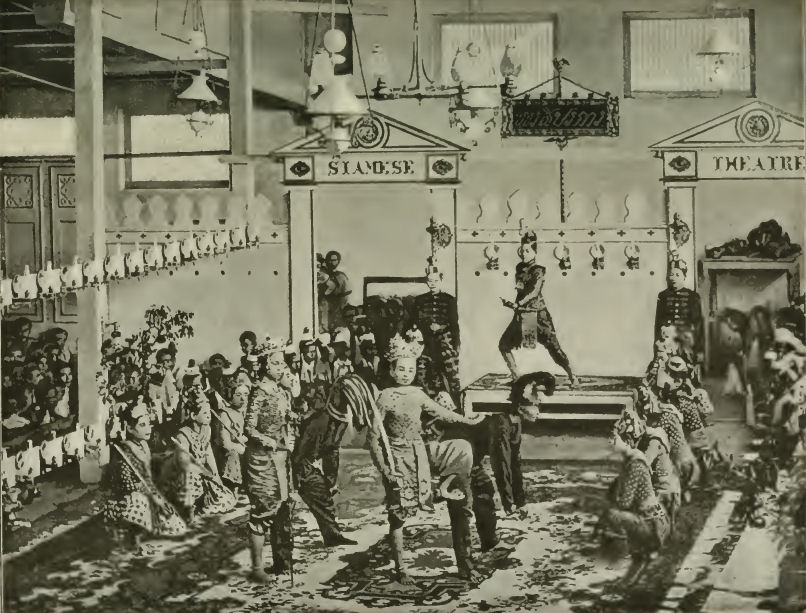
Abb.: Lakhon-Theater (ละคร),
Bangkok
[Bildquelle: Christmas, Walter <1861 - 1924>: Et aar i Siam. --
Kjøbenhavn : Hegel, 1894. -- S. 244]
Steuern und Abgaben um 1890
"STATEMENT OF TAXES AND SOURCES OP REVENUE OF THE SIAMESE GOVERNMENT.
(1) Taxes on exports: Principal article of export, rice, on which the duty is from 10 to 12 cents per picul.
(2) Taxes on imports: Uniform rate of 3 per cent, on the market value of the goods.
(3) Taxes on cultivated lands: About 60 cents an acre.
(4) Taxes on fruit trees, etc. : A list of the duties is given in the treaty. These taxes are in lieu of land tax.
(5) The revenue derived from certain monopolies which are either in the hands of Government or farmed out by them, viz.:
- Preparation and sale of opium.
- Manufacture and sale of spirits.
- Tax on gambling-houses.
- The collection and sale of edible birds' nests.
- The collection of turtles' eggs.
- The manufacture and sale of cakes and confectionery.
- The manufacture of iron pans.
- The manufacture of iron.
- Taxes on prostitutes.
(6) Taxes on houses, floating houses, shops, godowns, etc.; and on boats employed in a certain manner, viz.:
Boats
Ticals per fathom Boats engaged in carrying bricks 1 Boats engaged in carrying sand 1 Boats engaged in carrying tiles 1 Boats hawking miscellaneous hardware 1 North country boats bringing goods to Bangkok for sale ½ Boats moored with goods for sale, for more than two months, but under twelve months 1 Floating houses
Ticals per room With goods for sale 1½ to 3 Used as brothels 3 Used as lottery stations 3 Used as gambling-houses 3 Used as liquor shops 3 Those rented out 3 Houses godowns, shops, etc., on shore, with goods for sale, used as brothels, lottery stations, gambling houses, or liquor shops; also those rented out; if within the district guarded by the police, must pay 12½ per cent, of their annual rental; if not in the district of the police, must pay 8½ per cent, of the rental.
There is also a tax on fresh provision markets.
(7) Inland taxes:
Ticals per picul White sugar ½ Red sugar ¼ Peper 1
Per cent Fish (pla thoo) 8 1/3 Teel seed 8 1/3 Beans 8 1/3 Petchaboon tobacco 10 Silk 8 1/3 Beeswax 6 1/3 Raw cotton 10 Paw (vegetable fiber) 10 Indigo 10 Salt sea-fish 8½ Smoked fish 8½ Fresh fish 8½ Shrimp paste 10 Charcoal 10 Posts (wood) 10 Cocoanut oil 10 Red and white lime 10 Palm sugar 10 Molasses 8 1/3
Tin 10 Fire wood 20 Attap 10 Kacheng 10 Torches 10 Resin 10 Oil of fang tree 10 Rattans 10 Bamboos 10 Redwood 10
Ticals per picul Onions and chillis 10 Hemp (for sails) 10 Vegetables 5 Pork 8 1/3 Fowls 8 1/3 Ducks 8 1/3 Eggs of fowls or ducks 8 1/3
Per cent Blackwood
10 Mai Takean wood 10 Wood called Mai Phya Loi 10 Teakwood 10 Tobacco 10 Salt (per coyan, or 3/16 per cent, per picul.) ... 6 Ticals
(8) Taxes on implements used for catching fish in salt or fresh water:
Ticals
per annum
[Falls nichts anderes angegeben]Rafts, in line, to which nets are attached, for each aperture 4 Boats with large net 10 Boats with smaller net 6 Boats with small net 1 Boats with dragging net 10 Large round net streched on crossed bamboos with handle attached, per fathom 1½ Spoon-net, with wider mouth than 10 cubits 2 A boat with big spoon net ½ A boat with small spoon net 5/3 Basket used for catching fish in shallow water ¼ Net for the fish "Ta phien" 1 Harpoon or spear 1/3 "Laup" a long trap or basket 1½ A string of hooks ½ Each line for chawn or kado-fish 1/3 Small net stretched on two sticks 1/3 Scoop made of split bamboo ½ Other snares, from split bamboo ¼ to ½ Beds of water-plants in front of houses for attracting fishes, per fathom 1/3 Fish pools per fathom ½ The following are used in salt water:
Ticals
per annum
[Falls nichts anderes angegeben]Fishing stakes, disposed in a circle 6 Fishing stakes, disposed in a circle 12 Fishing stakes, in triangular form, with net at apex 3 One boat with hooks for dragging 2½ Fence for confining shrimps 1½ Casting net 1 Spoon net for shrimps and prawns 5/3 Fishing stakes 10 A large fishing boat 6 A very large net used by very many men 12 Boat for catching "pla kuraw" 4 "Lamoo" a large inclosure of bamboo 6 "Lamoo" for deeper water 20 Close bamboo fence 12 Close bamboo fence for deeper water 16 A kind of fishing net 16 Net for shrimps do 20 Net for beche de mer 24 Spears for beche de mer 4 Harpoon for turtle 8 Plank for sliding over the mud ½ Hook and line ¼ to ½ (9) The revenue derived from money paid in commutation of Government service, to which all adult males are liable, to which may be added the services performed by cowee [corvé].
(10) The revenue derived from a poll-tax of 4½ ticals on Chinese every third year.
(11) Taxes are also levied on theatrical representations and plays of various kinds.
Ticals per diem Drama of "Rama Kien" 28 Drama of "Anirut" 12 Theatrical representation "Nang" each night. ½ Chinese theater 2 Chinese puppet show 1 Drama "Ih Henao" 20 Dramas, various kinds 2 Singing ½ Chinese theater (special) 4 Note.—A picul, 133 1/3 pounds avoirdupois ; a Siamese tical, 60 cents."
[Quelle: Child, Jacob T.: The pearl of Asia. Reminiscences of the court of a supreme monarch : or, Five years in Siam. Chicago : Donohue, Henneberry & co., 1892. -- S. 148ff.]
1890 - 1940
Preise für einen Wasserbüffel bzw. einen Ochsen in der Umgebung Bangkoks in Baht, 1890 - 1940:
Abb.: Preise für einen Wasserbüffel bzw. einen Ochsen in der Umgebung Bangkoks in Baht, 1890 - 1940
[Datenquelle: Ingram (1971), S. 64]
1890 - 1902
Phraya Ratsadanupradit Mahitsaraphakdi (พระยารัษฎานุประดิษฐ์มหิศรภักดี, aka Khaw Sim Bee -許心美 / คอซิมบี้, 1857 - 1916) ist Gouverneur von Trang (ตรัง). Er führt den Anbau von Kautschukbäumen (Hevea brasiliensis) aus Malaya in Siam ein.
Abb.: Lage von Trang (ตรัง)
[Bildquelle: OpenStreetMap. -- Creative Commons Lizenz (Namensnennung, share alike)]
Abb.: Kautschuk-Plantage (Hevea brasiliensis), Koh Libong, Trang (ตรัง), 2012
[Bildquelle: Hanumann. -- http://www.flickr.com/photos/40883475@N00/6682160489/. -- ZUgriff am 2012-05-03. -- Creative Commons Lizenz (Namensnennung)]
Abb.: Phraya Ratsadanupradit Mahitsaraphakdi (พระยารัษฎานุประดิษฐ์มหิศรภักดี)
[Bildquelle: th.Wikipedia. -- Public domain]
"Phraya Ratsadanupradit Mahitsaraphakdi (Thai: พระยารัษฎานุประดิษฐ์มหิศรภักดี; 1857–1916, born Khaw Sim Bee (Thai: คอซิมบี้ , Chinese: 許心美) was a Thai provincial administrator. He is the youngest of the six sons[1] of Khaw Soo Cheang (许泗章 / คอซูเจียง, 1797-1882), a trader from Zhangzhou (漳州) in China.[2] As a member of the na Ranong (ณ ระนอง) family which held the governor's post in Ranong (ระนอง) for generations, Khaw was assigned to become governour of Trang (ตรัง) in 1890. His most significant contribution was the introduction of the rubber tree to Thailand, which at his time was only grown in Malaysia. It has since become one of the major crops of Thailand. He also initiated the connection of Trang with Nakhon Si Thammarat (นครศรีธรรมราช) and Phatthalung (พัทลุง) by road as well as the railroad connection to Nakhon Si Thammarat, one of the first railroads of Thailand.
In 1902 he was assigned to become the commissioner of Monthon Phuket (มณฑลภูเก็ต), which he stayed till his death in 1916.
A monument commemorating him was erected in the city of Trang. In 1992 he was also honored as one of the five most distinguished government officials in administration.
References
- ^ [泰国] 洪林, 黎道纲主编 (April 2006). 泰国华侨华人研究. 香港社会科学出版社有限公司. p. 184. ISBN 962-620-127-4.
- ^ Gary G. Hamilton (2006). Commerce and Capitalism in Chinese Societies. Routledge. p. 256. ISBN 0415157048."
[Quelle: http://en.wikipedia.org/wiki/Ratsadanupradit_Mahitsaraphakdi. -- Zugriff am 2012-05-03]
Warington Smyth (1867 - 1943) berichtet über Khaw Sim Bee:
The "dacoity" or banditry, which had once been particularly bad in Trang [ตรัง], "practically disappeared ... ten miles of road had been completed, six large wells had been sunk, a gaol, a courthouse and a landing pier had been built and hundreds of acres of padi had been cleared and drained"... [no other governor] ... can equal him in energy, popularity or good nature." [Zitiert in: Mackay, Colin <1936 - >: A history of Phuket and the surrounding region. -- Bangkok : White Lotus, 2013. -- 438 S. : Ill. ; 25 cm. -- ISBN 978-974-480-195-1. -- S. 329]
1890
Beginn des Baus von Khlong Rangsit (คลองรังสิต).
Abb.: Khlong Rangsit (คลองรังสิต), Postkarte, um 1900
Abb.: Übersichtskarte von Khlong Rangsit (คลองรังสิต) und Umgebung, Provinz Pathum Thani (ปทุมธานี)
[Bildquelle: Heinrich Damm / Wikipedia. -- GNU FDLicense]
Khlong Rangsit wurde 1890 von König Chulalongkorn (Rama V.) als erstes umfangreiches Projekt Siams zur Bewässerung ins Leben gerufen, um bisher brach liegendes Land des äußeren Chao-Phraya-Beckens für den Reisanbau zu nutzen. Da die Komplexität des Projekts westliche Technologie und Maschinenausstattung erforderte, wurde von der Regierung ein thailändisch-italienisches Joint Venture gegründet, die „Siam Land, Canals, and Irrigation Company“ (SLCIC). Der Gesellschaft wurde faktisch ein Monopol für den Bau von Kanälen und Erschließung von neuem Ackerland im ganzen Königreich für die nächsten 25 Jahre gewährt. Die Gesellschaft musste zwar die Baukosten aus eigenen Mitteln bestreiten, ihr wurde allerdings im Gegenzug das Recht zugebilligt, das Land, auf das sich das Projekt bezog, entweder weiterzuverkaufen oder selbst landwirtschaftlich zu nutzen. Prinz Sai Sanitvongse wurde zum Präsidenten des Projekts ernannt.
Der grundlegende Entwurf war einfach gestaltet. Ein zwölf Meter breiter und drei Meter tiefer Hauptkanal, der Khlong Rangsit, wurde in West-Ost-Richtung gegraben. Er begann am Ost-Ufer des Chao Phraya in der Gemeinde (Tambon) Ban Mai des Landkreises (Amphoe) Khlong Luang (อำเภอ คลองหลวง) in der Provinz (Changwat) Pathum Thani (ปทุมธานี). Er führt weiter in östlicher Richtung durch die historisch Thung Luang genannte Gegend bis hin zum Amphoe Ongkharak (อำเภอ องครักษ์) der Provinz Nakhon Nayok (นครนายก), wo er nach 54,8 Kilometer in eine Serie von Kanälen mündete, die weiter bis zum Nakhon-Nayok-Fluss führten. Nördlich und südlich des Rangsit-Kanals wurden im rechen Winkel 42 Neben-Kanäle gegraben. Sie waren jeweils sechs bis zehn Meter breit und 1,5 bis 2,5 Meter tief. Die 13 längsten Neben-Kanäle führten im Abstand 2,5 Kilometer vom Khlong Rangsit nach Norden, wo sie in einen parallelen Kanal, den Khlong Raphiphat mündeten.
Ein zweiter, ähnlicher Satz von Kanälen wurde ausgehend vom Khong Rangsit nach Süden zum Khlong Hok Wa geführt, der zwölf Kilometer südlich ebenfalls parallel zum Khlong Rangsit verlief. Khlong Hok Wa wurde nach Süden durch weitere Kanäle erweitert und Ost-West-Verbindungskanäle wurden zwischen einigen in Nord-Süd-Richtung verlaufenden Kanälen angelegt.
Die Ingenieure benutzten mechanische Schaufeln, die auf Schienfahrzeugen oder auf Barken montiert waren. In schwierigen Umgebungen wurden chinesische Lohnarbeiter verpflichtet, so dass im Jahr 1900 etwa 80.000 Hektar bearbeitet worden waren. Zum Ende der Vertragslaufzeit konnten 200.000 bis 240.000 Hektar neues Ackerland gewonnen werden.
Ab 1900 mehrten sich die Bedenken der Regierung über dieses Projekt. Man war besorgt, dass die landwirtschaftliche Entwicklung des Landes einer privaten Gesellschaft unterlag. Dadurch, dass die Gesellschaft das Wasser der ganzen Umgebung durch Schleusentore kontrollierte, verweigerte sie den Bauern Wasser, die ihre Felder direkt südlich bestellten. Der größte Verdruss ergab sich aber aus der Tatsache, dass die Regierung nicht in der Lage war, Einfluss auf die Qualität der Bauten auszuüben. Viele Kanäle waren nämlich zu schmal für ihre Tiefe und verlandeten bereits langsam, die SLCIC weigerte sich, diese Kanäle erneut auszubaggern. Nachdem nur 835 Kilometer des Systems fertiggestellt waren, wurde die SLCIC informiert, dass die Provisions-Übereinkunft widerrufen worden war und die Regierung nach einer neuen Lösung suche, nach der sie größere Kontrolle ausüben könne.
Im Juni 1902 wurde der holländische Wasserbau-Ingenieur Homan van der Heide vom soeben neu gegründeten Canal Department eingestellt, um sich des Bewässerungsproblems anzunehmen. Sein Vorschlag, den Chao Phraya durch den so genannten Chainat-Damm aufzustauen, wurde als zu kostenintensiv abgelehnt. Auch eine Modifizierung von van der Heides Plan, den Pasak-Fluss zu stauen, um so einen besserern Durchfluss der Rangsit-Kanäle zu erreichen, wurde erneut als zu teuer abgelehnt. Als 1909 Mißernten und Überschwemmungen vermehrt auftraten, wurde van der Heide − angeblich wegen Inkompetenz − wieder entlassen. (Der Chainat-Damm wurde im Rahmen des "Greater Chao Phraya Project" nach van der Heides Plänen im Jahre 1957 doch noch gebaut.)
Im Jahr 1915 entwickelte der britische Ingenieur Thomas Ward einen weiteren Plan, einen Damm im Pasak-Fluss (แม่น้ำ ป่าสัก) zu bauen, der dem Rangsit-Gebiet Vorteile bringen sollte. Dieser Staudamm, zunächst Pasak-Damm, später Rama-VII-Damm genannt, wurde nach kriegsbedingten Einschränkungen allerdings erst im Jahr 1924 fertiggestellt.
QuellenLiteratur
- Steve Van Beek: The Chao Phya, River in Transition. Oxford University Press, Kuala Lumpur 1995, ISBN 967-65-3069-7
- Han Ten Brummelhuis: King of the Waters. Homan van der Heide and the origin of modern irrigation in Siam. KITLV Press (Koninklijk Instituut voor Taal- Land- en Volkenkunde), Leiden 2005, ISBN 90-6718-237-0"
[Quelle: http://de.wikipedia.org/wiki/Khlong_Rangsit. -- Zugriff am 2011-10-10]
1890
Erste gedruckte Ausgabe der Sammlung von Schelmengeschichten um Sri Thanonchai (ศรีธนนท์ชัย / ศรีธนญชัย).
Abb.: Einbandtitel einer Thai-deutschen modernen Ausgabe
"Sri Thanonchai (Thai: ศรีธนนท์ชัย) ist eine Figur aus der thailändischen Volksliteratur, die ähnlich dem deutschen Till Eulenspiegel handelt und auch heute noch populär ist. Die meisten Episoden von Sri Thanonchai sind in der Zentralregion angesiedelt, wo die Figur wohl auch ihren Ursprung hat[1]. Die Figur des Sri Thanonchai
Gemäß den Erzählungen wurde Sri Thanonchai als Sohn einer Familie von Bauern in der Gegend von Ayutthaya (อยุธยา) geboren, nachdem die spätere Mutter sich nach langer Kinderlosigkeit im Gebet an den Gott Indra (พระอินทร์) wandte. Kurze Zeit darauf brachte die Mutter einen weiteren Sohn zur Welt, auf den Sri Thanonchai sehr eifersüchtig reagierte. Sri Thanonchai erweist sich als klug und gewitzt, aber auch zu recht drastischen Streichen aufgelegt. Er wird an den Hof des Königs berufen, wo seine Possen zwar sehr oft Hofschranzen verärgern, er aber immer wieder seine Haut retten kann. Schließlich kehrt er in sein Elternhaus zurück.
Über den Tod von Sri Thanonchai wird nur in wenigen Versionen seiner Lebensgeschichte aufgeklärt: nach einer verlorenen Wette mit einem Hofbeamten bricht ihm das Herz und er geht daran zugrunde.
PublikationsgeschichteDie älteste gedruckte Fassung der Geschichten um Sri Thanonchai wurde um 1890 publiziert, also rund 50 Jahre nach der Etablierung der thailändischen Druckerpresse.
Die Erzählungen von Sri Thanonchai sind nicht nur in ganz Thailand verbreitet, sondern darüber hinaus auch in Laos (dort Chieng Mieng (Xieng Mieng) genannt[2]), Kambodscha (Thanon-Chai) und Vietnam bekannt.
Die laotische Erzählungen folgen weitgehend den thailändischen Versionen, mit einer Ausnahme: Chieng Mieng stand dabei im Dienste des laotischen Königs, als sich ein Angriff der Siamesen abzeichnete. Der König zog den Schlaukopf zu Rate, der empfahl, alle Löcher und Gruben der Stadt Vientiane (ວຽງຈັນ) fest zu verschließen, so dass die Siamesen nicht eindringen konnten. Auf diese Weise wurden jedoch der mythischen Schlange Naga sämtliche Wege versperrt, wie sonst üblich den Laoten zu Hilfe zu kommen. Vientiane fiel an Siam. Von den laotischen Erzählungen gibt es eine französische Übersetzung[3].
Die kambodschanischen Erzählungen um Thanon-Chai (Thmenh Chey) weichen von den thailändischen beträchtlich ab. Auch von diesen gibt es eine französische Übersetzung[4]
[Quelle: http://de.wikipedia.org/wiki/Sri_Thanonchai. -- Zugriff am 2015-05-15]
1890
Über die Presse in Bangkok um 1890:
"This is no land for newspapers, the history of the press of Siam is a novel one. There are now two English printed papers published there, the Times, semi-weekly, at $20 per annum, and the Advertiser weekly, at $24 per annum. They represent the two extremes, one favorable to the Siamese, the other in decided opposition. For a half century the missionaries have endeavored to keep pace with the times by publishing an annual calendar and newspapers. By their efforts several papers have been started, but they somehow have always been brought up in the consular courts charged with libel, on the most frivolous pretexts, and suspended. In 1864 a Mr. Chandler, an American, started the Siam Times, but General Partridge, our consul, not liking his style, the Times soon ceased to circulate. Dr. Bradley then started the Bangkok Recorder, but the American consul, who it appears did not like newspapers, at the conclusion of a libel suit brought by the French consul against the Doctor decided that he was libelous and must be fined because he had published a report current in the palace that the French consul had demanded the removal of the Prime Minister. As the paper was not paying and the Doctor had to settle the bill, he concluded that running a paper was not a part of his mission, and the Recorder slept the sleep that knows no awakening, not even issuing another number to record its demise. The Siam Monitor then sprung up, but the American consul having come to the conclusion that Bangkok was an unhealthy city for newspaper enterprise the Monitor went out with the mango showers. Rev. Sam J. Smith then stepped to the front and started the Siam Weekly Advertiser, which he continued to publish for seventeen years, more as an advertising sheet than a disseminator of news, but supposing that the era of libel had passed he was startled when he was brought up by a round turn and met the fate of his predecessors, for when he was called on to pay $1,500 by the English consul for publishing a communication that he had not written or even endorsed, not libelous in a general sense, he shut up shop and said the paper could go to a warmer place than Siam, that the proud privilege of running a paper was exhausting his exchequer and he would have no more of it, in fact it had never paid. This ended the efforts of the missionaries to keep up a paper.
Appreciating the power of the press, if properly handled, the Siamese officials endeavored to keep the Advertiser afloat by offering to subscribe for one hundred and fifty copies, provided that they would be allowed to exercise a censorship over its columns, but the proprietor had had enough of glory and the paper still remains with the honored dead. Then an eccentric genius, a cosmopolitan, as much at home in Paris as at Singapore, who had had some experience on the Hong Kong papers, drifted into Bangkok, stood in with the Siamese officials and now publishes, in fact, the first newspaper that has ever been published in the city. During its existence it has published more libelous articles than any of its predecessors, but it still lives. To counteract its influence a German, who had a grievance with the Siamese government, started the Mercantile Gazette; he made things hot all along the line, made his paper readable, but he was soon, arrested for libeling the Siamese by publishing an article clipped from an English paper and other assaults on the King. He was tried before the German consul, fined and imprisoned ; the Gazette then shortly followed the others, his speculation proved a failure, but another paper has been started with the same material, possibly to share the same fate.
The Siamese have, strictly speaking, no regular newspaper, only a Government Gazette, printed in Siamese, which contains court proceedings, proclamations, ceremonies, promotions, etc., containing no political or other news of importance, and has but a limited circulation. A native journal was started by Noi Plang, a well educated Siamese, who had passed a very creditable examination at the English bar and who acts as one of the advisors of the government. His paper was rapidly becoming popular, but his remarks were trenching on dangerous grounds, in fact he had commenced to advocate that the Chinese were becoming too numerous in Siam, which was something that His Majesty thought should be let alone, so his paper venture was nipped in the bud just as it was blossoming out into usefulness. Mr. Smith, the editor of the defunct Advertiser, edits and publishes a Siamese paper from his office which is interesting from the native correspondence appearing in its columns. It has no life in it and is but little read. A monthly journal is published under the auspices of one of the leading nobles, which aims at Western ideas in its endeavors to give the current news, but it receives but a meager support, having a very small circulation.
The Siamese are great readers, but it is the most trashy stuff, strictly oriental and frequently of the most obscene nature, the native novels abounding in the filthiest stories told in the grossest manner; in fact all oriental literature is of that nature, but highly poetical. This they read and it is in great demand. Thousands of novels of this character are printed in Bangkok which find ready sale at good prices. A collection of Siamese novels, histories and other works would form quite a library, especially their religious works. They are not far enough advanced to appreciate newspapers, caring but little for the news of the outside world."
[Quelle: Child, Jacob T.: The pearl of Asia. Reminiscences of the court of a supreme monarch : or, Five years in Siam. Chicago : Donohue, Henneberry & co., 1892. -- S. 329ff.]
1890
Gründung des Royal Medical College
"Royal Medical College, to which is attached the Siriraj (Wang Lang) Hospital. This college was founded in R.S. 108 (1890), and passed out its first graduates (9 in number) in R.S. 112 (1894). In R.S. 123 (1903) the growing demand for medical men brought about a reorganisation of the college, providing for a greater number of students and an amplified course of studies. Up to the year R.S. 123 (1903) (that is, in fifteen years) only 56 students had graduated from the college, an average of less than four a year. The college was then placed under the control of the Education Department, the number of students increased, and in the last three years (R.S. 124-126) 50 students have successfully passed through the improved course. All lectures are given in Siamese by 10 lecturers (5 Siamese, 5 foreigners), and the course covers three years in theory and practice, followed by an examination. The successful students are then required to take an additional year of practice under observation, no diploma being granted to a student who does not successfully pass through this fourth year of practice. At the present time (June, 1908) there are 109 students taking the medical course, of whom 104 are in residence. Besides the above medical course there are separate small branches for the training of (i.) dressers and ward attendants, and (ii.) maternity nurses which it is hoped will develop in the future. The students of the college practice throughout their course in the Siriraj (Wang Lang) Hospital attached to the college."
[Quelle: W. G. Johnson in: Twentieth century impressions of Siam : its history, people, commerce, industries, and resources / ed. in chief: Arnold Wright. -- London [etc.] : Lloyds, 1908. -- S. 229f.]
1890
Gründung der "Royal State Railways of Siam".
"Geschichte Vorarbeiten
König Chulalongkorn der Große (Rama V.), der seit 1868 regierte, erteilte Panchard unter der Führung von Sir Andrew Clarke den Auftrag, Pläne für ein Eisenbahnnetz auszuarbeiten. Drei Jahre später lagen diese mit Vorschlägen in drei verschiedenen Spurweiten 600, 1000 und 1435 mm vor. Im Herbst des gleichen Jahres kam der Eisenbahningenieur Karl Bethge von Krupp nach Thailand und bekam von der thailändischen Regierung diese Pläne zur Begutachtung vorgelegt. Es gelang ihm nachzuweisen, dass die Bahn von Bangkok nach Korat (Nakhon Ratchasima), die 265 Kilometer lang sein sollte, wesentlich preisgünstiger gebaut werden könnte.
Die thailändische Regierung berief den vorher in Deutschland zum königlichen preußischen Baurat beförderten Bethge in den thailändischen Staatsdienst. Er wurde Leiter des Eisenbahnbaus. Dies war auch ein Schritt, um die thailändische Neutralität zwischen den konkurrierenden Kolonialmächten Großbritannien (Indien, Burma, Malaya, Singapur) und Frankreich (Indochina) und damit seine Unabhängigkeit zu wahren. Die Arbeiten wurden allerdings - entgegen dem Rat von Bethge - an die englische Firma Murray Campbell als günstigster Bieter vergeben. Die Leitung des Baues übernahm G.M. Campbell.
Die thailändische Eisenbahn wurde im Jahre 1890 als Royal State Railways of Siam gegründet.
BauNach zweijähriger Vorbereitung wurde durch Proklamation von König Chulalongkorn am 9. März 1892 der Bau der ersten Eisenbahnlinie Thailands freigegeben. Die dabei verwendeten Werkzeuge, ein reich verzierter Spaten und die dazugehörige Schubkarre, sind heute im Nationalmuseum Bangkok zu sehen.
Karl Bethge verpflichtete weitere deutsche Ingenieure für den Bahnbau, Hermann Gehrts (* 1854 - † 1914) und Luis Weiler (* 1836- † 16. Januar 1918), beide von den Preußischen Staatseisenbahnen. Luis Weiler wurde leitender Ingenieur für die Strecke nach Korat (Nakhon Ratchasima). Weiler berichtete seinem Vater, der ebenfalls Eisenbahningenieur war, in zahlreichen Briefen von seiner Arbeit. Diese sind nahezu alle erhalten geblieben und befinden sich heute im Archiv des Deutschen Museums in München.
EröffnungAm 26. März 1894 wurde der erste Abschnitt, die Strecke Bangkok – Ayutthaya eröffnet.
Die Eisenbahnverwaltung kündigte zum 1. September 1896 dem englischen Unternehmen den Vertrag, da diese Firma die Bauarbeit nicht vertragsgemäß erfüllte. Die Arbeiten wurden nun in eigener Regie übernommen. Die Strecke war zu diesem Zeitpunkt 135 Kilometer lang.
Im Dezember 1896 nutzte König Chulalongkorn die Gelegenheit, mit dem Zug bis zur Bahnspitze zu fahren. An einem überhängenden Felsen bei Kilometer 136,5 schrieb er seinen Namen auf den Felsen. Der stark verwitterte Schriftzug ist heute noch zu sehen.
1897 dauerte eine Fahrt zwischen Bangkok und Korat (Nakhon Ratchasima) 6 Stunden, vor dem Bahnbau dauerte die Reise 5 Tage.
AusbauBethge war im Jahr 1900 an Cholera gestorben und dessen Nachfolger Gehrts plante im Jahr 1904 in den Ruhestand zu treten. Im Frühjahr 1904 erreichte deshalb Luis Weiler in Haifa, wo er am Bau der Hedschasbahn beschäftigt war, die Berufung zum Generaldirektor der thailändischen Bahnen. Als er seine Stelle antrat, war die Koratbahn fertiggestellt, und die Südbahn hatte Petchaburi erreicht. Bei diesem Projekt hatte man eine abweichende Spurweite gewählt: die Nordbahn war als Normalspurbahn mit 1435 mm, die Südbahn aber in Meterspur angelegt. Die größte Schwierigkeit beim Bahnbau war die Beschaffung von Arbeitskräften. Da Thais nur schwer zu mobilisieren waren, wollte Weiler Japaner einsetzen. Der König entschied letztlich, Chinesen anzuheuern. Zu Weilers Aufgaben gehörte auch, den König auf seinen Bahnreisen im Hofzug zu begleiten. Dies geschah erstmalig am 7. August 1904, als der König einen Sonderzug für eine Fahrt von Bangkok nach seiner Sommerresidenz Bang Pa In bestellt hatte.
Bei der Lieferung der Lokomotiven, schnitten deutsche Firmen wie Henschel und Krupp besonders gut ab. 1909 fuhren insgesamt 49 Lokomotiven aus deutscher Produktion für die thailändische Staatsbahn. Waggons wurden hauptsächlich aus Deutschland, Belgien, den Niederlanden und Großbritannien importiert.
Die Weiterführung der Südlinie und der Ostlinie bereiteten große politische Schwierigkeiten. Der Süden und Westen gehörten zum englischen, der Osten zum französischen Einflussgebiet. Die thailändische Regierung wollte zum Ende des Jahres 1906 an den Ausbau der Südlinie gehen, was auf den Widerspruch der Engländer stieß. Diese verlangten den Bau der Eisenbahn unter englischer Leitung, was Thailand aber vermeiden wollte. Daher wurden alle Anstrengungen auf den Bau der Nordlinie (Bangkok – Chiang Mai) konzentriert, die nicht in der französischen oder englischen Interessensphäre lag.
In den ersten Tagen des Jahres 1908 wurde die Ostlinie nach Paetriu (heute: Chachoengsao) und die im Endausbau 751 Kilometer lange Nordlinie bis Phitsanulok bei Kilometer 389 fertiggestellt. Am 11. November, dem Krönungstag, konnten weitere 67 Kilometer auf der Nordstrecke eröffnet werden. Somit waren nun 844 Kilometer Strecke in Betrieb. Zu diesem Zeitpunkt befanden sich 228 Europäer im thailändischen Staatsdienst, davon 45 Deutsche und allein 35 bei der Bahn. Für Entwurf und Bau zahlreicher wichtiger Bahnhofsgebäude in Nord- und Zentralthailand war beispielsweise der deutsche Architekt Karl Döring verantwortlich.
Im Frühjahr des Jahres 1909 stellte die Regierung den Bau der Nordbahn ein und führte den Bau der Südlinie unter der Leitung des Engländers Gittins weiter. Dies war Folge eines mit den Engländern abgeschlossenen Vertrages, durch den die Sultanate Tsinganu (Terengganu), Kelantan und Kedah an Großbritannien abgetreten werden mussten. Als Gegenleistung gaben die Engländer eine Anleihe von vier Millionen Pfund für den Bau der Südlinie.
1910 wurde ein neuer Güterbahnhof für Bangkok eröffnet, in dem die Fracht direkt von Flussschiffen auf die Bahn umgeladen werden konnte und der Grundstein zum Bangkoker Hauptbahnhof Hua Lamphong gelegt. Die Stahlkonstruktion der Empfangshalle stammte aus deutscher Produktion, der Bau wurde von einer italienischen Firma ausgeführt. 1916 wurde er eröffnet.
Ab 1912 wird die Nordlinie weitergebaut. Zwischen Lampang und Chiang Mai war ein 1,6 Kilometer langer Tunnel erforderlich. Die Arbeiten am Khun Tan Tunnel leitete der deutsche Ingenieur Emil Eisenhofer. Als Eisenhofer 1962 hochbetagt starb, wurde er am Nordausgang des Khun Tan Tunnels beigesetzt.
Erster WeltkriegNach dem Beginn des Ersten Weltkriegs kam der Eisenbahnbau nahezu zum Stillstand, viele deutsche Ingenieure verließen das Land. Thailand konnte seine anfängliche Neutralität auf Dauer nicht aufrechterhalten. Um einen Ausgleich zwischen den immer stärker auseinander gehenden deutschen und englischen Interessen beim Bahnbau zu finden, wurde Prinz Purachatra zum Generalkommissar der Staatsbahnen, der englische Eisenbahningenieur Gittins zum Eisenbahnberater und Luis Weiler zum Chefingenieur ernannt. Auch wurden die beiden Eisenbahnverwaltungen West und Ost vereinigt. Diese Lösung hielt jedoch nur kurze Zeit. Am 22. Juli 1917 erklärte Thailand unter dem Druck der Entente Deutschland den Krieg. Weiler wurde, ebenso wie alle anderen Deutschen, interniert, nachdem er noch kurz zuvor mit dem Weißen-Elefanten-Orden II. Klasse ausgezeichnet worden war. 1918 vorzeitig aus der Internierung entlassen, verließ Weiler mit Genehmigung der thailändischen Regierung als schwerkranker Mann das Land und starb auf der Rückreise auf einem dänischen Schiff vor der Ostküste Afrikas."
[Quelle: http://de.wikipedia.org/wiki/State_Railway_of_Thailand. -- Zugriff am 2011-10-20]
"Karl Bethge (* 14. Februar 1847 in Berlin; † 11. April 1900 in Bangkok) war ein deutscher Ingenieur. Nach abgeschlossenem Studium zum Bau- und Maschinenbauingenieur war Bethge seit 1871 bei der Österreichischen Südbahn tätig und wechselte 1873 zur Gotthardbahn-Gesellschaft über, wo er an der Planung und am Bau der Gotthardbahn beteiligt war. Nach der Tätigkeit bei der Neubauverwaltung der Rheinischen Eisenbahn-Gesellschaft (1877 bis 1879) legte er die Bauführerprüfung (1. Staatsexamen) und 1881 die Baumeisterprüfung (2. Staatsexamen) ab. Kurze Zeit im technischen Büro des preußischen Ministeriums der öffentlichen Arbeiten in Berlin beschäftigt, trat er später in den Dienst der serbischen Eisenbahnverwaltung und war verantwortlich für den Bau einiger Eisenbahnbrücken. 1885 hielt er sich als Vertreter von Krupp in China und zu Studienzwecken in Japan auf.
1891 wurde er vom siamesischen König Chulalongkorn (Rama V.) als Berater nach Bangkok eingeladen, wo er im November 1891 eintraf. Aufgrund seiner konstruktiven Vorschläge zur Verbesserung der siamesischen Eisenbahn wurde er bereits im folgenden Jahr zum Generaldirektor des Ressorts Königliche Eisenbahn (Royal Railway Department) im Ministerium für Tiefbau berufen. Er blieb Generaldirektor bis zu seinem Tod im Jahr 1900. Unter seiner Leitung und nach seinen Vorstellungen wurde die „Nagara Rajasema Railway“, die Bahnstrecke von Bangkok nach Korat (heute Nakhon Ratchasima) fertiggestellt, die heute zur State Railway of Thailand gehört.
Er war Mitglied der Burschenschaft Germania Berlin.[1]
LiteraturEinzelnachweise
- R. Ramaer: The Railways of Thailand. White Lotus, Bangkok 1994, ISBN 974-8495-02-3 (formal falsche ISBN).
- Anny Kochherr: Karl Bethge. In: Neue Deutsche Biographie (NDB). Band 2, Duncker & Humblot, Berlin 1955, S. 186.
- Adressen-Verzeichnis der Alten Herren der Berliner Burschenschaft "GERMANIA" (E.V.). Ausgabe S.-S. 1911. S. 11."
[Quelle: http://de.wikipedia.org/wiki/Karl_Bethge. -- Zugriff am 2011-10-20]
1890
In Phuket Town (นครภูเก็ต) gibt es 685 shop-houses (店屋 / ห้องแถว), davon sind
- 318 Ziegelbauten
- 367 Holzbauten
Abb.: Shop-houses, Phuket (ภูเก็ต), 1903
1890

Gründung der protestantischen Missionsstation in Phuket (ภูเก็ต)
1890

Es erscheint
Hallett, Holt Samuel <1845 - 1911>: A thousand miles on an elephant in the Shan states. -- Edinburgh : Blackwood, 1890. -- 484 S. : Ill. ; 23 cm. -- Die Reise hat 1884 stattgefunden
Abb.: Titelblatt
Abb.: Map of Southern China and Indo China showing proposed French & English railways
[a.a.O., Frontispiece]
Abb.: An execution
[a.a.O., S. 33]
Abb.: Fishing implements used in Siam
[a.a.O., S. 168]
Abb.: Fishing implements used in Siam
[a.a.O., S. 168]
Abb.: Chinese pack-saddle
[a.a.O., S. 212]
Abb.: Ox drawing timber in forest
[a.a.O., S. 308]Über Chiang Mai (เชียงใหม่):
"CHAPTER X.
CHOW OO-BOON, A SPIRIT-MEDIUM — CONSULTING ANCESTRAL SPIRITS— AX EXORCIST—SPIRIT OF WITCHCRAFT—ILL-TREATING A PATIENT-TREATMENT OF WITCHES FALSE CHARGES MISSIONARY DESTROYS AN IMAGE —EXECUTION OF CHRISTIANS PROCLAMATION IN FAVOUR OF CHRISTIANS — MISSIONARIES PROTECT WITCHES — UNDERMINE SUPERSTITION—GHOSTS PERCHING ON TREES—A MISSIONARY GHOST — HEADLESS DEMONS—A DEMONIAC.
After breakfast I went next door to have another chat with Mr Wilson. He told me that Chow Oo-boon had great power with the members of the Government, who were all connected with the royal family; because, besides being the queen’s sister, she was the spirit-medium of the family. As an instance of her power, he stated that when called in to consult the spirits after the late Chow Hona, or second-king, was struck down with sickness, she boldly told him that the spirits were displeased at his oppression of the people, and advised him at once to abolish certain vexatious taxes, particularly the monopoly of arrack, or rice-spirit.The method practised when consulting the beneficent spirits—who, like mortals, are fond of retaliating when provoked—is as follows: When the physician’s skill has been found incapable of mastering a disease, a spirit-medium—a woman who claims to be in communion with the spirits— is called in. After arraying herself fantastically, the medium sits on a mat that has been spread for her in the front verandah, and is attended to with respect, and plied with arrack by the people of the house, and generally accompanied in her performance by a band of village musicians with modulated music.
Between her tipplings she chants an improvised doggerel, which includes frequent incantations, till at length, in the excitement of her potations, and worked on by her song, her body begins to sway about, and she becomes frantic, and seemingly inspired. The spirits are then believed to have taken possession of her body, and all her utterances from that time are regarded as those of the spirits.On showing signs of being willing to answer questions, the relations or friends of the sick person beseech the spirits to tell them what medicines and food should be given to the invalid to restore him or her to health; what they have been offended at; and how their just wrath may be appeased. Her knowledge of the family affairs and misdemeanours generally enables her to give shrewd and brief answers to the latter questions. She states that the Pee—in this case the ancestral, or, perhaps, village spirits—are offended by such an action or actions, and that to propitiate them such-and-such offerings should be made. In case the spirits have not been offended, her answers are merely a prescription; after which, if only a neighbour, she is dismissed with a fee of two or three rupees, and, being more or less intoxicated, is helped home.
In case the spirit-medium’s prescription proves ineffective and the person gets worse, witchcraft is sometimes suspected, and an exorcist is called in. The charge of witchcraft means ruin to the person accused, and to his or her family. It arises as follows: The ghost or spirit of witchcraft is called Pee-Kah. No one professes to have seen it, but it is said to have the form of a horse, from the sound of its passage through the forest resembling the clatter of a horse’s hoofs when at full gallop. These spirits are said to be reinforced by the deaths of very poor people, whose spirits were so disgusted with those who refused them food or shelter that they determined to return and place themselves at the disposal of their descendants to haunt their stingy and hard-hearted neighbours. Should any one rave in delirium, a Pee-Kah [ผีกะ] is supposed to have passed by.
Every class of spirits—even the ancestral spirits, and those that guard the streets and villages—are afraid of the Pee-Kah [ผีกะ]. At its approach the household spirits take instant flight; nor will they return until it has worked its will and retired, or been exorcised. Yet the Pee-Kah, as I have shown, is itself an ancestral spirit, and follows as their shadow the son and daughter, as it followed their parents through their lives. It is not ubiquitous, but at one time may attend the parent and at another the child, when both are living. Its food is the entrails of its living victim, and its feast continues until its appetite is satisfied, or the feast is cut short by the incantations of the spirit-doctor or exorcist. Very often the result is the death of its victim.
When the exorcist, spirit-doctor, or witch-finder is called in and asked whether he considers the patient is suffering from a Pee-Kah, he puts on a knowing look, and after a cursory examination of the person, generally declares it to be so. His task is then to find out whose Pee-Kah is devouring the sick person. After calling the officer of the village and a few head-men as witnesses, he commences questioning the invalid. He first asks, “ Whose spirit has bewitched you? " The person may be in a stupor, half unconscious, half delirious from the severity of the disease, and therefore does not reply. A pinch or a stroke of a cane may restore consciousness. If so, the question is repeated; if not, another pinch or stroke is administered. A cry of pain may be the result That is one step towards the disclosure; for it is a curious fact that, after the case has been pronounced one of witchcraft, each reply to the question, pinch, or stroke is considered as being uttered by the Pee-Kah through the mouth of the bewitched person.
A person pinched or caned into consciousness cannot long endure the torture, especially if reduced by a long illness. Those who have not the wish nor the heart to injure any one often refuse to name the wizard or witch until they have been unmercifully beaten.
On the sick person naming an individual as the owner of the spirit, other questions are asked—such as, “ How many buffaloes has he? ” “How many pigs? ” “How many chickens? ” “ How much money? ” &c. The answers to the questions are taken down by a scribe. A time is then appointed to meet at the house of the accused, and the same questions as to his possessions are put to him. If his answers agree with those of the sick person, he is condemned and held responsible for the acts of his ghost.
The case is then laid before the judge of the court, the verdict is confirmed, and a sentence of banishment is passed on the person and his or her family. The condemned person is barely given time to sell or remove his property. His house is wrecked or burnt, and the trees in the garden cut down, unless it happens to be sufficiently valuable for a purchaser to employ an exorcist, who for a small fee will render the house safe for the buyer; but it never fetches half its cost, and must be removed from the haunted ground. If the condemned person lingers beyond the time that has been granted to him, his house is set on fire, and, if he still delays, he is whipped out of the place with a cane. If he still refuses to go, or returns, he is put to death.
The late King of Zimmé [Chiang Mai -เชียงใหม่], on hearing from the villagers of the Karen [กะเหรี่ยง] village of Ban Hta, that their head-man was bewitching them and would not leave the village, allowed the people to club him to death. About three years before my visit another case came to the knowledge of the missionaries, where two Karens were brought to the city by some of their neighbours, charged with causing the death of a young man by witchcraft. The case was a clear one against the accused. The young man had been possessed of a musical instrument, and had refused to sell it to the accused, who wished to purchase it Shortly afterwards he became ill, and died in fourteen days. At his cremation, a portion of his body would not burn, and was of a shape similar to the musical instrument It was clear that the wizards had put the form of the coveted musical instrument into his body to kill him. The Karens were beheaded, notwithstanding that they protested their innocence, and threatened that their spirits should return and wreak vengeance for their unjust punishment Witches and wizards in the Shan States are free agents and have made no compact with the devil. The old Burman custom for the trial of witches was similar to that practised in former times in England: the thumbs and toes being tied together, the suspected person was thrown into the water, and sinking was a proof of innocence, floating of guilt.
In Mr Wilson’s opinion, the charge of witchcraft often arises from envy, or from spite; and sickness for the purposes of revenge is sometimes simulated. A neighbour wants a house or garden, and the owner either requires more than he wishes to pay, or refuses to sell it at all. Covetousness consumes his heart, and the witch-ghost is brought into action. Then the covetous person, or his child, or a neighbour, falls ill, or feigns illness; the ailment battles the skill of the physician, and the witch-finder is called in. Then all is smooth sailing and little is left to chance.In the early days of the Mission at Zimmé, Christians were very unfavourably looked on by the officials. This may partly have arisen from what I consider to have been, under the circumstances, an injudicious act of a missionary. An old temple-ground was handed over to the missionaries as a compound for their houses and schools. The temple was in ruins, but a sandstone image of Buddha, five feet in height, was intact, and was much reverenced by the people, who placed offerings of fruit and flowers before it. The missionaries used the ruins of the temple for levelling the ground, and buried the image under the débris. One day during some alterations it was dug up, and the people swarmed into the compound to pay their respects to it, although it had lost its head. The missionary then took an axe and knocked it to pieces before the people, who were naturally horrified and offended at the, to them, sacrilegious deed. The people were still more disgusted by seeing the pedestal upon which the image had been seated turned into a garden scat, and the fragments of the image made into a rockery.
Another cause of friction arose in 1869 from two new converts neglecting to aid in repairing the palisading round the outer city when instructed to do so by the officials. The missionaries believed that the affair arose merely from a misunderstanding. Anyhow, the two converts were seized, and fastened with ropes passed through the holes in their ear-laps to the upper beams of a house, and next day clubbed to death. The missionaries complained to the King of Siam, and a Siamese official was sent up to inquire into the case. The King of Zimmé, being bound to Siam only so far as tribute and his foreign relations were concerned, answered the commissioner by stating that it was his affair and not Siam's, and that he intended to kill as many of his own people as he chose. It was not till nine years afterwards, in the present king’s reign, five years after the appointment of the Siamese commissioner at Zimmé, that a proclamation, issued by the Siamese Government, declaring that any of the Siamese Shans might change their religion with impunity, was allowed to be placarded up in the Court of Zimme. At the time of my visit, the missionaries had made nearly two hundred converts and were much respected by the princes and the people.
Besides converting the people and opening schools for their education, the missionaries have been doing their utmost to conquer the belief of the people in witchcraft; and I was glad to hear that it had become a custom with several of the princes of Zimmé and the neighbouring States, as well as other intelligent people, to call in the aid of the physician attached to the Mission in cases of serious illness in their families. Another blow has been given to superstition by the missionaries sheltering those who lie under the accusation of witchcraft. At the time of my visit sixteen accused families were residing in the Mission grounds, some of whom had been converted to Christianity: and most of the children were attending the. schools.
The people account for no harm having happened to the missionaries through their harbouring witches by saying that the Pee-Kah are afraid of Europeans, and clamber up the tamarind-trees near the gate of the Mission when the witches go in, and wait until they leave the yard to enter them again.
One of the trees outside the compound was much dreaded by people who had to pass near it. The cries of the spirits were often heard from its branches at night. At times the spirits descended to the ground and confronted passers-by. One of them resembled a child about a year old; then, in a second, its form would expand and grow until it was taller than the tree, when it would vanish after forcing a scream of horror from the affrighted beholder. This ghost for some reason assumed the appearance of a missionary.
One day Mr Wilson saw a fire built close to the tree, and two men squatting near it. On approaching them he noticed that one was holding two small chickens over the flames, whose feathers were already half consumed. The other had a bundle of bamboo splints, which he was sticking into the ground to support a platform, upon which the fowls, when roasted, were to be offered to the spirits.
This was too much for the embodied missionary, who, much to their dismay, insisted upon their taking their offerings out of his compound.When visiting Dr Peoples, the physician attached to the Mission, he told me of a strange case of hysteria which arose from the belief of the Shans in evil spirits. There was a man living in the northern quarter of the city who possessed a garden of areca palms and plantains. In the garden was a well, the abode of a Pee-Hong, or headless spirit: all deceased murderers, adulterers, and other people who have been executed become Pee-Hong. In its way to and from this well the Pee-Hong passed through a grove of trees, which the owner, against the wishes of his neighbours, who feared the wrath of the demon, determined to cut down. A short time after the trees had been destroyed he became very uneasy and unwell; and whenever thinking or talking on the subject, figures appeared on his limbs and body, in the form of regular welts, shaped like leaves and trunks and whole trees—sometimes resembling plantain-trees, at others areca palms. Having tried every form of exorcism, he applied to Dr Peoples for help through his medical assistant, but refused to display the spirit manifestations before him, saying that they would not appear before Christians. The doctor prescribed for the man, and went to visit him the next day at his house, but he had left his family and started for a famous shrine. Many months had passed since then, but nothing further had been heard of the demoniac.
The belief in the transmigration of the soul into the bodies of animals is apt to give rise to a peculiar form of hallucination. In one of the Siamese books a tale is told of a wife plotting the death of her affectionate husband with her paramour, and, on the success of the plot, marrying the latter. Soon afterwards the woman noticed a snake in the house, which she thought must be her late husband, as she imagined it looked lovingly upon her. After killing the snake she had a cow which she killed for the same reason. Then she had a dog which followed her everywhere with affectionate watchfulness, and she, thinking her husband’s soul must be in it, killed it. After the dog’s death a child was horn, who, because it looked at her with loving eyes, she thought must be her husband. Not daring to cut short its life, and unable to bear the sight of it, she gave it out to be nursed. When the child grew up, it is said to have remembered the various migrations of its soul from the time that it was the husband of its own mother, and to have told the story to its grandmother."
[a.a.O., S. 105 -112]
Über Bordelle in Bangkok:
"The state of morality amongst the officials in Bangkok may be judged from the fact that many of the princes and nobles treat the brothel-keepers, some of whom wear his Majesty's uniform, as bosom friends, and are seen riding in the same carriage with them. The description of the brothels in Bangkok, as given to me by one of the police inspectors, was most revolting. The prostitutes are all slaves, having been sold by their nearest relations in order to pay their gambling debts, or to aid their parents who are in the clutches of the law, the parents promising to buy them back as soon as they can. As a rule, they are said to be far more modest and particular than the same class of women in Europe. Previous to being sold into a brothel, the girl has to be taken to the Lord Mayor’s office, where she is asked if she consents to become a prostitute. Often, although hardly able to speak for tears, they dare not refuse, and a mere gesture is taken for consent. Their relations are allowed to flog them within an inch of their life, and if they do not die within fifteen days of their flogging, their death is not considered to have been caused by it. There is therefore no chance for a girl to escape her doom in the brothel. On being sold she has to declare that she was born before 1868 (the year when the king came to the throne), for otherwise she could not be sold for more than two guineas (22 ticals). The law is easily evaded, like every other law in Siam. If a girl says she is thirty-three or thirty-four when she is only fifteen, the officials would not take the trouble to question her assertion, and if they did, their conscience would soon be satisfied with a small bribe.
Every night when the house is closed, the inmates sit in a circle on the floor and sing or chant a prayer for their health and prosperity and for that of their owner. This in most houses is compulsory, but it becomes habitual to the girls. Each night one or two of the girls must, turn and turn about, provide oil for the lamps, and flowers for decorating the rooms, out of any presents they have received. If one of them has received no presents, she is considered by her owner to have been lax in her blandishments, and receives a good Hogging. The howls of these poor creatures, together with the whish of the cane, is heard through the city in the early hours of the morning.
The magistrates in Bangkok have the reputation of being the biggest liars in the country, and the police are said to be the greatest thieves. So unsafe are the people from false charges and lawsuits, that they willingly become the slaves of the powerful in order to gain their protection. Thus, according to the inspector, not five per cent of the Siamese in Bangkok are in possession of their freedom."
[a.a.O., S. 452f.]
Über Chinesen und Leibeigene
"Chinese immigrants not European subjects are considered by the Siamese to be under their jurisdiction, and are subjected to the laws of the realm. After three years’ residence, and at the close of every three years from that date, they have to pay a tax of 4¼ ticals, equivalent to 8s. 6d. They are exempted from corvée labour, and all other Government requisitions, except the ordinary taxes. Their children have the option of submitting to the triennial tax, or of selecting a Government master and becoming Siamese. The grandchildren of Chinese immigrants are classed and registered as Siamese, and are liable to corvée labour as soon as they measure 21 sok [ศอก], or 50 inches, to the shoulder, and are marked to one or other Government master. The mark is tattooed on the back of the right or left wrist, and all persons thus marked are liable to be called out in their master’s department. The people and the Government are both imposed upon by the unscrupulous officials. Marked men die. The master avers that the man had not served for a number of years, and claims arrears of money, equivalent to the value of the labour he has omitted to do, from his wife and family. As certificates for times served are not given, no available proof can be brought to show the dishonesty of the master’s claim. Either the sum must be paid or a paper of indebtedness must be made out giving the master the power of selling the family, or as many of them as will cover the amount of the declared deficit.
Another mode of making money out of the people is as follows: On receiving an order for the services of a certain number of men, the master calls many more than are required, and says he has to choose so many from them. They all naturally want to beg off: those who offer the smallest bribe have to serve. If instead of men being requisitioned, the order is for posts, or other materials, oppression comes similarly into play. Some years ago the king requisitioned ten posts from the minister of certain provinces, the minister ordered twenty from the governor, who ordered forty from the Samien [เสมียน], who ordered eighty from the masters of the prai-luangs [ไพร่หลวง], who made the prai-luangs cut a hundred and sixty, on the plea that some of them would be hollow or otherwise imperfect."
[a.a.O., S. 461f.]
1890
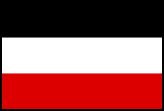
Das Deutsche Reich verhandelt heimlich mit Siam, auf Phuket (ภูเก็ต) einen Stützpunkt für den Kohlennachschub deutscher Schiffe zu erhalten. Auf Druck Großbritanniens bricht Siam die Verhandlungen ab.
Abb.: Lage von Phuket (ภูเก็ต)
[Bildquelle: Scottish Geographical Magazine, 1886. -- Public domain]
1890

Gründung des Deutschen Klubs in Bangkok.
Abb.: Deutscher Klub Bangkok
[Bildquelle: Twentieth century impressions of Siam : its history, people, commerce, industries, and resources / ed. in chief: Arnold Wright. -- London [etc.] : Lloyds, 1908. -- S. 252]
"THE DEUTSCHER KLUB. The social centre and general meeting-place for German residents in Bangkok is the Deutscher Klub, which was founded, with an original membership of 40, some eighteen years ago. During the first years of its existence the Klub had a small rented house as its headquarters, for its present premises in Suriwongse Road [ถนนสุริวงศ์] were not erected until 1896. The building is surrounded by well-laid-out grounds, containing tennis-courts, &c, and the Klub has now 135 members, which means practically every German resident in Siam. Membership is not rigidly confined to Germans, but is open to all persons who have German sympathies and speak the German language fluently. H.R.H. Prince Nakonsuwan [Paribatra Sukhumbandh, Prinz von Nakhon Sawan, 1881 - 1944], on his return to Siam after completing his military education in Germany, was elected a member of the Klub at his own request. Ladies are admitted to the Klub on all ordinary occasions. They have their own reading-room, and are entitled to make free use of the library, which is an excellent one, comprising German, English, and French books. The club is also provided with billiard-tables, a bowling-alley, and a gymnasium for the entertainment of the members. The management of the Klub is vested in a committee, elected annually. The office-holders for 1908 are—President, F. Lutz ; hon. secretaries, C. Zippert and A. Link ; hon. treasurer, A. Osann ; committee : E. Guergen, P. Hein, and M. Mansfeldt."
[Quelle: Twentieth century impressions of Siam : its history, people, commerce, industries, and resources / ed. in chief: Arnold Wright. -- London [etc.] : Lloyds, 1908. -- S. 252f.]
1890
Beginn der Rechtsanwaltskanzlei Tilleke & Gibbins.
"Tilleke & Gibbins is a full service law firm with over 100 lawyers in Bangkok, Hanoi, and Ho Chih Minh City. The firm represents the top investors and the high-growth companies that drive economic expansion in Asia in the key areas of commercial transactions and M&A, dispute resolution and litigation, and intellectual property. History
The firm started in 1890, the year when William Alfred Tilleke, a young, highly accomplished Ceylonese lawyer, landed in Siam (now Thailand) to start his career as a solicitor.[1] In 1894, Tilleke gained recognition when he successfully defended Phra Yot Muang Kwang, a Thai provincial governor, who had been accused of murdering a French military officer.[2][3] In the face of colonial pressure by the French and before a French Court conducted in Thailand, a brilliant cross examination by Tilleke exonerated Phra Yot through affirmative evidence and all seven judges returned with a Not Guilty verdict.[4] Ralph Gibbins, an Englishman, joined the firm in 1902 and later became a legal advisor in the Siamese Ministry of Justice, and then a judge of the International Court in 1916.
Samuel Brighouse and Reginald Atkinson led the firm from 1911 until Thailand’s involvement in World War II in 1941. During the war, the firm was safeguarded by Ina Jorgensen, who was the secretary of Tilleke & Gibbins partner Victor Jaques. In 1946, Mr. Jaques ran the firm as the sole partner remaining after the war had ended.
In 1951, Albert Lyman purchased the firm from Victor Jaques for $2,500. Mr. Lyman and his wife, Freda, ran the firm with a Thai partner, Rojvit Periera. The Lymans’ son, David, joined the firm in 1967 and took over Tilleke & Gibbins’ operations after his father’s death in 1984."
[Quelle: http://en.wikipedia.org/wiki/Tilleke_%26_Gibbins. -- Zugriff am 2012-06-15]
ca. 1890
Beginn der Einwanderung von Meo / Hmong (แม้ว / ม้ง / Mèo / H'Mông / 苗族) nach Siam.
Abb.: Lebensräume der Meo / Hmong (แม้ว / ม้ง) in Thailand 1970
[Bildquelle: Minority groups in Thailand / Joann L. Schrock [u. a.]. -- Washington: Headquarters, Dept. of the Army, 1970. -- 1135 S. : Ill. ; 24 cm. -- (Ethnographic study series) (Department of the Army pamphlet ; no. 550-107). -- S. 572]
1890


"In 1890, many Frenchmen saw in the conquest of Tonkin [Vietnam] only another of Bismarck’s [Otto Eduard Leopold von Bismarck-Schönhausen, 1815 - 1898]clever moves to divert French energies into colonizing channels and away from the Rhine, where he was plotting some nefarious scheme. The very absence of German monkey-wrenches in the way of French Far Eastern expansion seemed to them in itself suspicious." [Quelle: Thompson, Virginia <1903 - 1990>: French Indo-China. -- London : Allen, 1937. -- 516 S. ; 24 cm. -- S. 100. -- Fair use]
1890

Der US-Chirurg William Stewart Halsted (1852 - 1922) verwendet erstmals sterilisierte medizinische Handschuhe.
1890-03
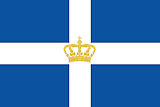
Besuch von Prinz Georg von Griechenland (Πρίγκιπας Γεώργιος της Ελλάδας, 1869 - 1957) in Siam.
Abb.: Prinz Georg von Griechenland (Πρίγκιπας Γεώργιος της Ελλάδας)
[Bildquelle: Wikimedia. -- Public domain]
1890-04-01 - 1890-07-31

Dritte Nationale Industrie-Ausstellung in Tokyo (Japan). Über 1 Mio. Besucher. Nach Besuch dieser Ausstellung soll Sakichi Toyoda (豊田 佐吉, 1867 - 1930) den Vorsatz gefasst haben: "Ich werde alle ausländischen Waren aus Japan hinauswerfen." Toyoda Sakichi ist der Vater von Toyoda Kiichirō (豊田 喜一郎, 1895–1952), dem Gründer der Toyota Motor Corporation (トヨタ自動車株式会社). Toyota wird die führende Automarke Thailands werden.
Abb.: Dritte Nationale Industrie-Ausstellung in Tokyo (Japan)
[Bildquelle: http://www.ndl.go.jp/exposition/e/s1/naikoku3.html. -- Zugriff am 2013-10-05. -- Public domain]
1890-04-16

Rama V. reist in die Südprovinzen und nach Singapur.
1890-07-01

Erste Parlamentswahlen (第1回衆議院議員総選挙) in Japan.
1890-08-06

New York (USA): erste Hinrichtung auf dem elektrischen Stuhl. Das Verfahren gilt als besonders human. In Thailand werden noch im 20. Jahrhundert zum Tode Verurteilet von unfähigen Schützen erschossen.
Abb.: Erste Hinrichtung auf dem elektrischen Stuhl 1890
[Bildquelle: Le Petit Parisien - Supplément littéraire illustré, 1890-08-17 / Wikimedia. -- Public domain]
1890-09


Der US-presbyterianische Missionar Robert Irwin (1859 - 1943) kommt nach Siam.
"Irwin, Robert (1859-1943) Irwin was a Presbyterian missionary who served with the Laos Mission. He was born on 5 September 1859 in Garafraxa, Ontario and graduated from Pardee College, Missouri in 1887. He graduated from McCormick Theological Seminary in 1890 and was ordained by Platte Presbytery in June 1890. He arrived in Bangkok in September of that same year. He married Dr. Mary Alameda Bowman (1864-1954) in July 1898. His ministry with the Laos Mission was marked by controversy because of his faith in the northern Thai churches to lead themselves. In 1894-1895, he played a key role in an attempt to place pastors in most churches, an attempt that led to misunderstanding and reluctance on the part of the Laos Mission to engage in such an experiment again. While stationed at Nan [น่าน] from 1895 to 1900, he developed a plan for new church development that would encourage churches to take responsibility quickly for themselves; that plan came to an end with the mission transferred the new Christian groups involved to the care of other stations. In 1903 to 1905, Irwin prepared the Phrae [แพร่] Church to run its own life without missionary supervision, which it then did until 1912, when the Laos Mission reopened the Phrae Station. The Irwins resigned from missionary work in February 1906, but they returned to Bangkok in 1911 where Irwin was manager of the American Bible Society agency until 1932. He died in December 1943."
[Quelle: Dictionary of Thai Christianity. -- http://www.herbswanson.com/dictionary.php. -- Zugriff am 2013-10-05]
1890-09-01

Der Deutsche Postassistent Theodor Collmann (1867 - 1949) wird als Leiter des Hauptpostamtes in Bangkok entsandt. Er ist bei der Post Siams bis 1910 beschäftigt.
1890-09-16
Bangkok bekommt elektrisches Licht.
1890-10-19
Es erscheint:
ดำรงราชานุภาพ <สมเด็จพระเจ้าบรมวงศ์เธอ กรมพระยา> [Damrong Rajanubhab] < 1862 - 1943>: วิชชาสำหรับตัวเด็ก [Weisheit für Kinder]. -- In: วชิรญาณพิเศษ [Wachirayan wiset]. -- 5 (1890-10-05). -- Damrong ist Unterrichtsminist6er!
"Prince Damrong was himself not wholeheartedly convinced of the necessity for great improvements in the old- style monastery schools, his view at this time being that beyond a minimal knowledge of reading and writing most boys needed only the simplest common sense education in
- "morality,
- cooking,
- sewing,
- climbing trees,
- swimming,
- building shelters,
- planting trees, and
- keeping animals,"
all of which could be taught by a boy’s parents and relatives, except for those few boys who looked toward careers in government, commerce, or the crafts and professions."
[Quelle: Wyatt, David K. <1937 - 2006>: The politics of reform in Thailand : education in the reign of King Chulalongkorn. -- New Haven : Yale UP, 1969. -- 425 S. : Ill. ; 23 cm. -- (Yale Southeast Asia studies ; 4). -- SBN 300-01156-3. -- S. 141]
1890-10-27

Der französische Forschungsreisende, Diplomat und Spion Auguste Pavie (1847 - 1925) an den Gouverneur von französisch Cochinchina, Charles LeMyre de Vilers (1833-1918):
Abb.: Lage von Luang Prabang [ຫຼວງພະບາງ], Vientiane [ວຽງຈັນ],Nakkhon Phanom [นครพนม], Champassak [ຈໍາປາສັກ], Ubon Ratchathani [อุบลราชธานี]
[Bildquelle: Scottish Geographical Magazine. -- 1886. -- Public domain]
'Si le fleuve paraît à première vue une limite rationnelle, la pratique ne tarderait pas à nous embarrasser. La moitié des principautés de Luang Prabang [ຫຼວງພະບາງ], Vien Chan [Vientiane - ວຽງຈັນ], Lakhone [Nakkhon Phanom - นครพนม], Champassak [ຈໍາປາສັກ], Oubone [Ubon Ratchathani - อุบลราชธานี] est sur la rive droite. Les Siamois ne les possèdent pas autrement qu'en qualité de tributaires. Notre action les enrichirait donc si nous prenions des chefs de notre côté, de la moitié des territoires de ceux-ci. Le Mékong [ແມ່ນ້ຳຂອງ / แม่น้ำโขง] n'est la limite d'aucun canton, arrondissement ou province....' [Zitiert in: Tuck, Patrick J. N.: The French wolf and the Siamese lamb : the French threat to Siamese independence, 1858-1907. -- Bangkok : White Lotus, 1995. -- 434 S. : Ill. ; 22 cm. -- ISBN 974-8496-28-7. -- S. 358, Anm. 23]
1890-10-30

Der japanische Kaiser erlässt das Kaiserliche Erziehungsedikt (教育ニ関スル勅語). Rama V. wird 1910 dieses als Vorbild für Siam vorschlagen.
Abb.: Das Kaiserliche Erziehungsedikt (教育ニ関スル勅語)
[Bildquelle: Wikimedia. -- Public domain]
"The Imperial Rescript on Education (教育ニ関スル勅語 Kyōiku ni Kansuru Chokugo) was signed by Emperor Meiji ((明治天皇, 1852 – 1912) of Japan on 30 October 1890 to articulate government policy on the guiding principles of education on the Empire of Japan. The 315 character document was read aloud at all important school events, and students were required to study and memorize the text. Background
Following the Meiji Restoration, the leadership of the Meiji government felt the need to emphasize the common goals of rapid modernization (westernization) with support and legitimization of the political system centered on the imperial institution. In the 1870s and 1880s, Motoda Nagazane (元田 永孚, 1818 - 1891) and other conservatives pushed for a revival of the principles of Confucianism as a guide for education and public morality; however, Inoue Kowashi (井上 毅, 1843 – 1895) and other proponents of the 'modernization' of Japan felt that this would encourage a return to the old feudal order, and pushed for an "emperor-centered" philosophy. Prime Minister Yamagata Aritomo (山縣 有朋, 1838 – 1922) authorized the drafting of the Rescript, which was a compromise written largely by Inoue Kowashi with input from Motoda Nagazane and others.
After it was issued, the Rescript was distributed to all schools in the country, together with a portrait of Emperor Meiji.
DetailsThe Rescript requested of the people that they "furthermore advance public good and promote common interests; always respect the Constitution and observe the laws; should emergency arise, offer yourselves courageously to the State; and thus guard and maintain the prosperity of Our Imperial Throne coeval with heaven and earth".
The basis of the Rescript was that Japan's unique kokutai (國體) was based on a historic bond between benevolent rulers and loyal subjects, and that the fundamental purpose of education was to cultivate virtues, especially loyalty and filial piety.
After World War II, the American occupation authorities forbade the formal reading of the Imperial Rescript in schools, and the Diet of Japan (国会) officially abolished it on 19 June 1948."
[Quelle: https://en.wikipedia.org/wiki/Imperial_Rescript_on_Education. -- Zugriff am 2015-10-11]
"Know ye, Our subjects: Our Imperial Ancestors have founded Our Empire on a basis broad and everlasting and have deeply and firmly implanted virtue; Our subjects ever united in loyalty and filial piety have from generation to generation illustrated the beauty thereof. This is the glory of the fundamental character of Our Empire, and herein also lies the source of Our education.
Ye, Our subjects, be filial to your parents, affectionate to your brothers and sisters; as husbands and wives be harmonious, as friends true; bear yourselves in modesty and moderation; extend your benevolence to all; pursue learning and cultivate arts, and thereby develop intellectual faculties and perfect moral powers; furthermore advance public good and promote common interests; always respect the Constitution and observe the laws; should emergency arise, offer yourselves courageously to the State; and thus guard and maintain the prosperity of Our Imperial Throne coeval with heaven and earth.
So shall ye not only be Our good and faithful subjects, but render illustrious the best traditions of your forefathers. The Way here set forth is indeed the teaching bequeathed by Our Imperial Ancestors, to be observed alike by Their Descendants and the subjects, infallible for all ages and true in all places. It is Our wish to lay it to heart in all reverence, in common with you, Our subjects, that we may thus attain to the same virtue.
The 30th day of the 10th month of the 23rd year of Meiji. (Imperial Sign Manual. Imperial Seal.)" [Quelle: https://en.wikisource.org/wiki/Imperial_Rescript_on_Education. -- Zugriff am 2016-03-26]
1890-11
Der neugegründete Bangkok City Cricket Club spielt erstmals.
1890-11-05
Bangkok Times über das Auftreten des Militärs bei der königlichen Kathin-Prozession [ทอดกฐิน]:
"We fancy that the forces displayed on this occasion should be sufficient to make John Chinaman understand the utter hopelessness of attempting to kick up his heels against the government...It should also prove to Europeans living in Bangkok... that the Siamese government has forces at its disposal sufficient for immediately quelling any disturbance in Bangkok or elsewhere in the country, should occasion arise." [Zitiert in: Battye, Noel Alfred <1935 - >: The military, government, and society in Siam, 1868-1910 : politics and military reform during the reign of King Chulalongkorn. -- 1974. -- 575 S. -- Diss., Cornell Univ. -- S. 297]
1890-12-04
Der deutsche Bakteriologe Emil Behring (1854 - 1917) und der japanische Bakteriologe Kitasato Shibasaburō (北里 柴三郎, 1853 - 1931) veröffentlichen den Aufsatz „Über das Zustandekommen der Diphtherieimmunität und der Tetanusimmunität bei Thieren“. Er gilt als Grundlage der Serumtherapie (Immunserum, passive Impfung).
Abb.: Karikatur auf Behring und die Serumtherapie in: Lustige Blätter, 1894
[Bildquelle: Wellcome Images. -- Creative Commons Lizenz (Namensnennung, keine kommerzielle Nutzung)]
Abb.: Robert Koch bei Familie Kitasato
[Bildquelle: Wellcome Images. -- Creative Commons Lizenz (Namensnennung, keine kommerzielle Nutzung)]
1890-12-18

Die City and South London Railway (C&SLR) nimmt ihren Betrieb auf. Es ist "älteste in tief liegenden, gebohrten Röhren errichtete U-Bahn der Welt und die erste, die elektrisch betrieben wird." (Wikipedia)
Abb.: C&SLR, 1890
[Bildquelle: Illustrated London News, 1890-11-08 / Wikimedia. -- Public domain]
Abb.: Untergrund-Bahn (U-Bahn), Bangkok, 2007
[Bildquelle: Ian Fuller. -- http://www.flickr.com/photos/18684820@N00/414512047. -- Zuggriff am 2013-10-11. -- Creative Commons Lizenz (Namensnennung, keine kommerzielle Nutzung)]
ausführlich: http://www.payer.de/thailandchronik/ressourcen.htm
Phongpaichit, Pasuk <ผาสุก พงษ์ไพจิตร, 1946 - > ; Baker, Chris <1948 - >: Thailand : economy and politics. -- Selangor : Oxford Univ. Pr., 1995. -- 449 S. ; 23 cm. -- ISBN 983-56-0024-4. -- Beste Geschichte des modernen Thailand.
Ingram, James C.: Economic change in Thailand 1850 - 1870. -- Stanford : Stanford Univ. Pr., 1971. -- 352 S. ; 23 cm. -- "A new edition of Economic change in Thailand since 1850 with two new chapters on developments since 1950". -- Grundlegend.
Akira, Suehiro [末廣昭] <1951 - >: Capital accumulation in Thailand 1855 - 1985. -- Tokyo : Centre for East Asian Cultural Studies, ©1989. -- 427 S. ; 23 cm. -- ISBN 4896561058. -- Grundlegend.
Skinner, William <1925 - 2008>: Chinese society in Thailand : an analytical history. -- Ithaca, NY : Cornell Univ. Press, 1957. -- 459 S. ; 24 cm. -- Grundlegend.
Mitchell, B. R. (Brian R.): International historical statistics : Africa and Asia. -- London : Macmillan, 1982. -- 761 S. ; 28 cm. -- ISBN 0-333-3163-0
Smyth, H. Warington (Herbert Warington) <1867-1943>: Five years in Siam : from 1891 to 1896. -- London : Murray, 1898. -- 2 Bde. : Ill ; cm.
ศกดา ศิริพันธุ์ = Sakda Siripant: พระบาทสมเด็จพระจุลจอมเกล้าเจ้าอยู่หัว พระบิดาแห่งการถ่ายภาพไทย = H.M. King Chulalongkorn : the father of Thai photography. -- กรุงเทพๆ : ด่านสุทธา, 2555 = 2012. -- 354 S. : Ill. ; 30 cm. -- ISBN 978-616-305-569-9